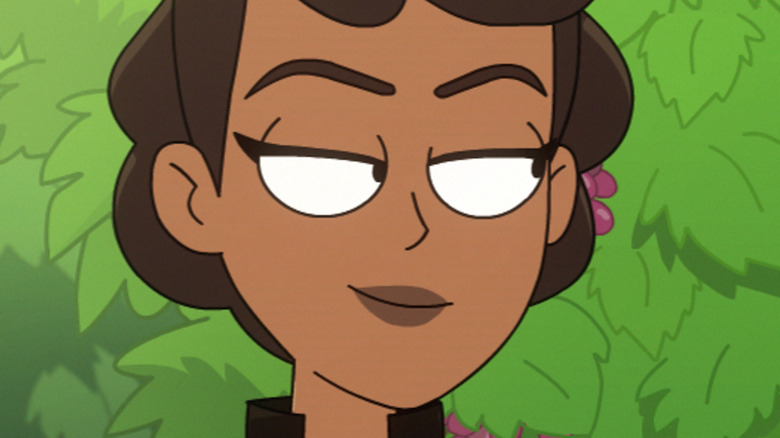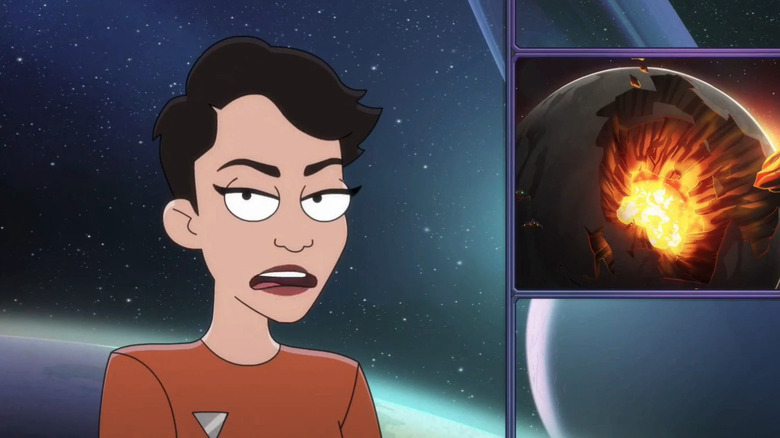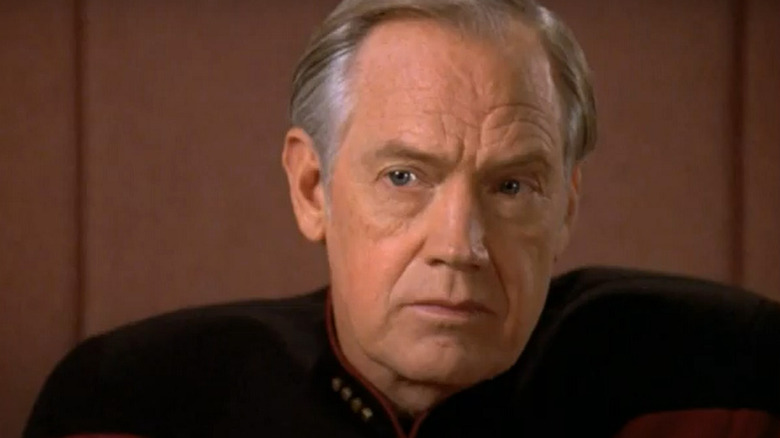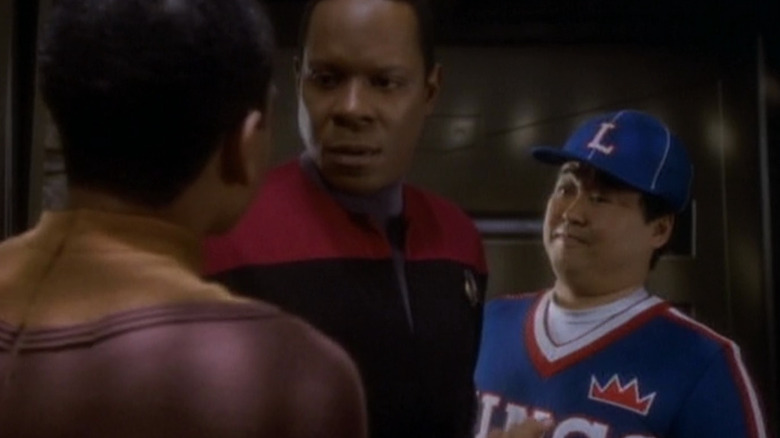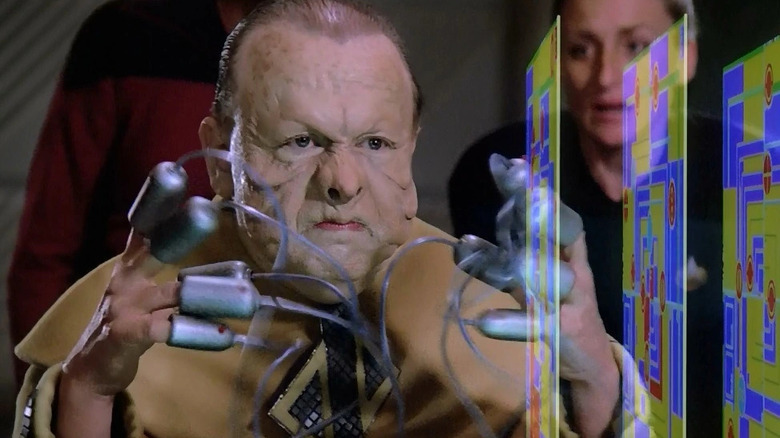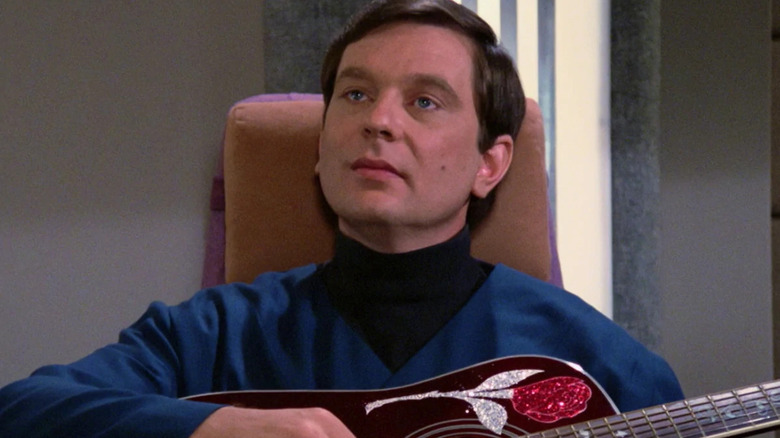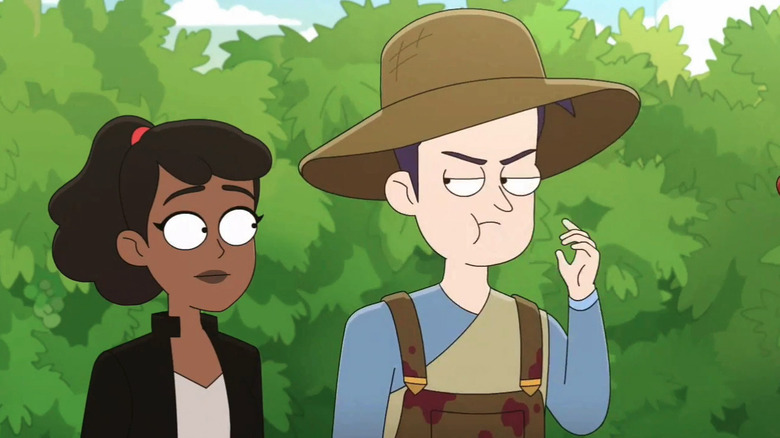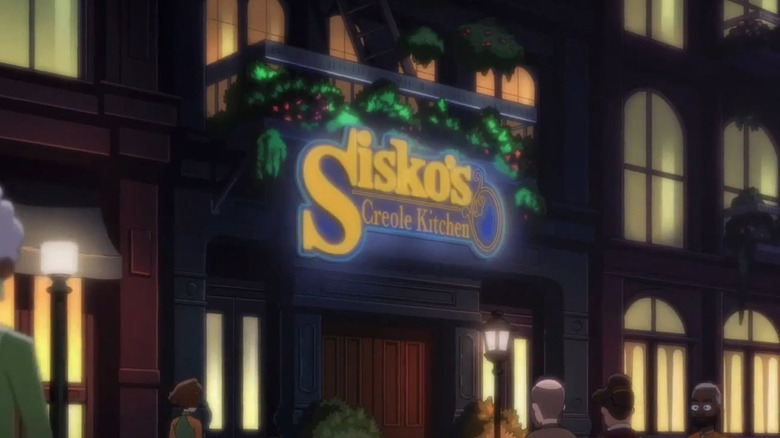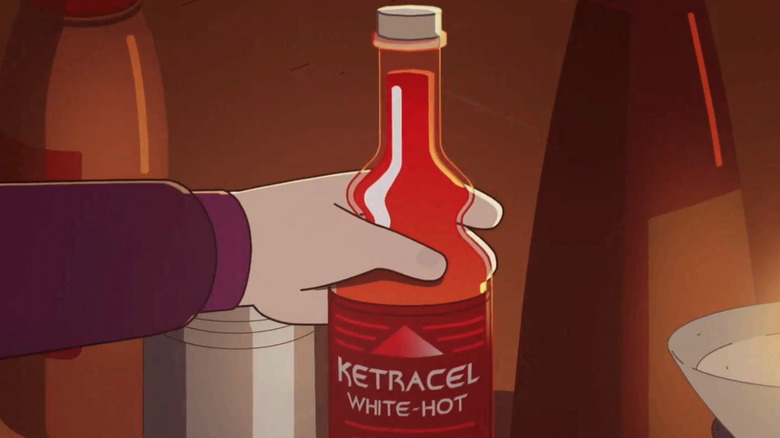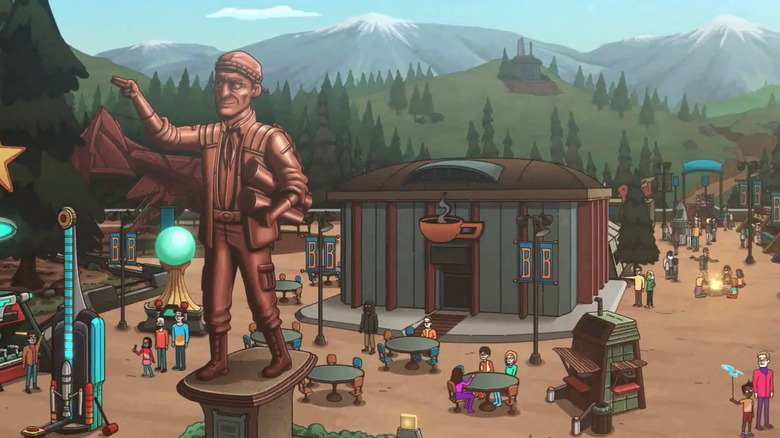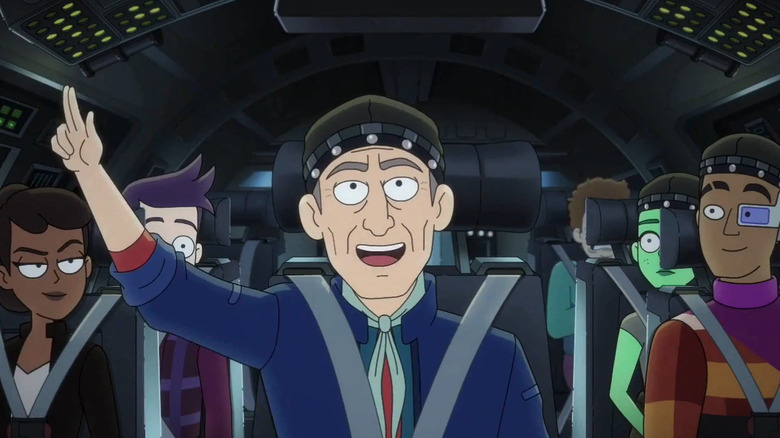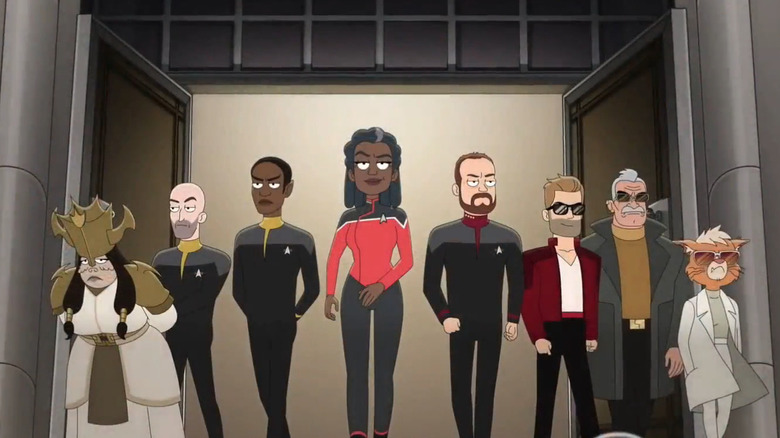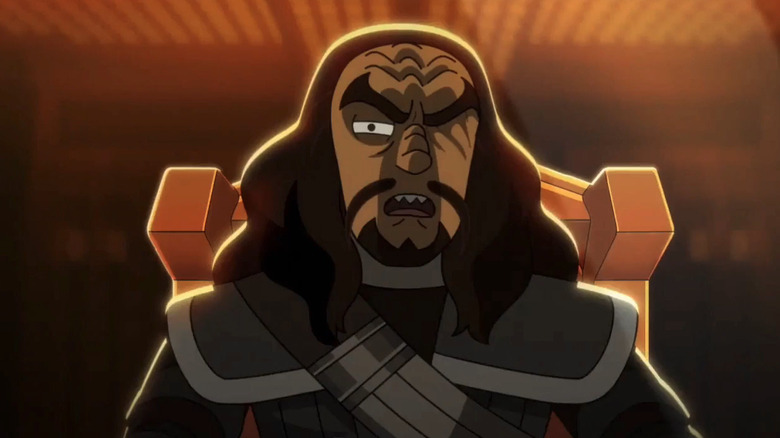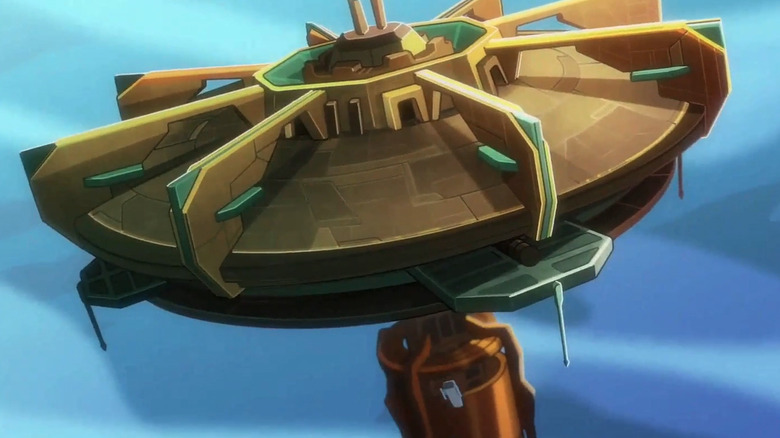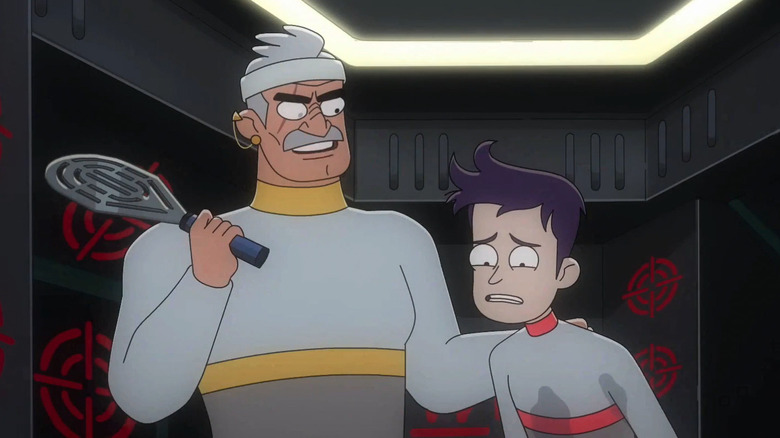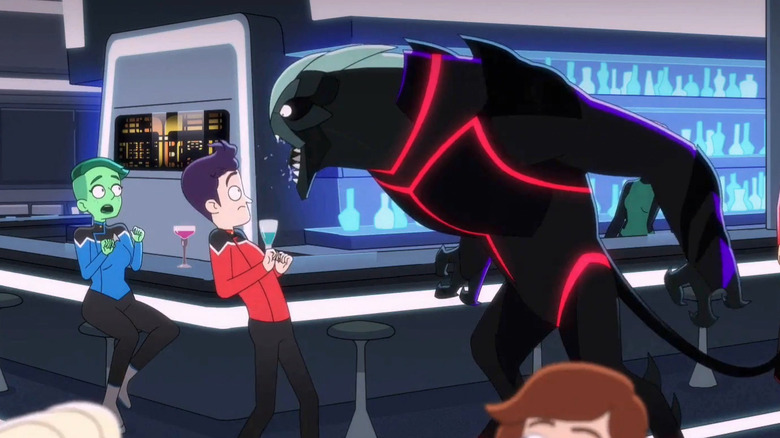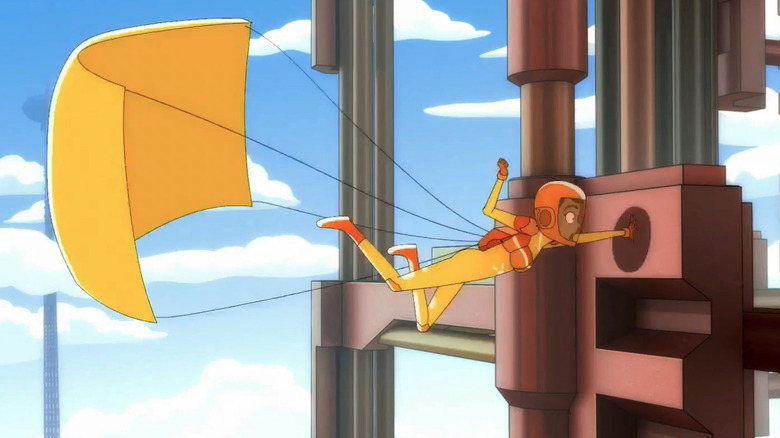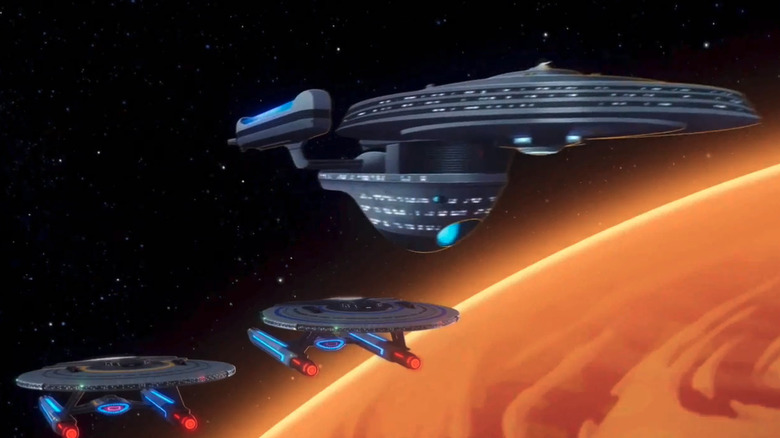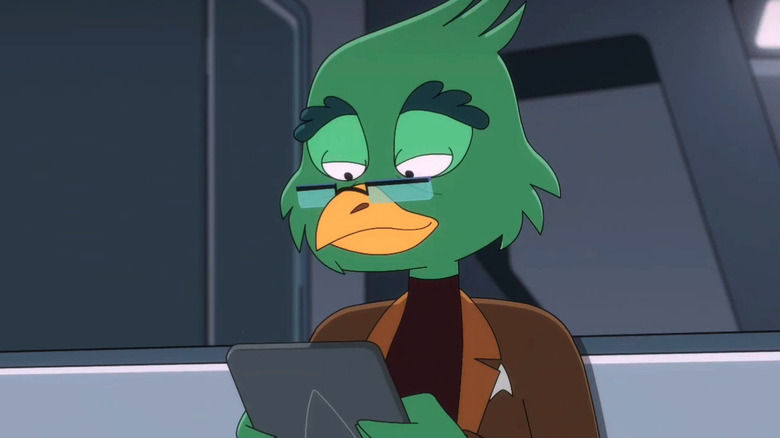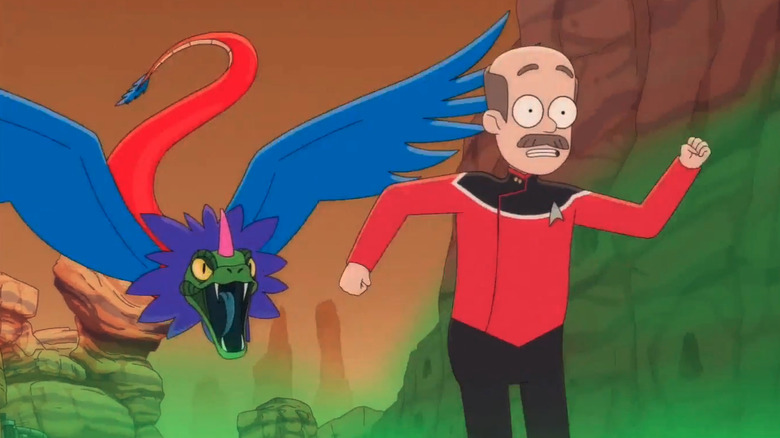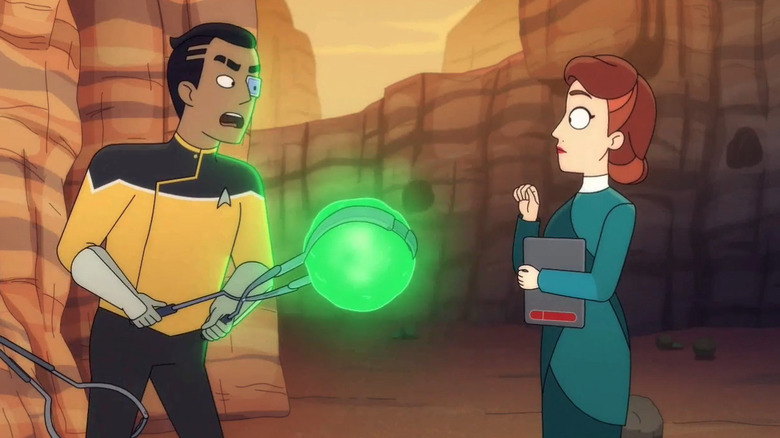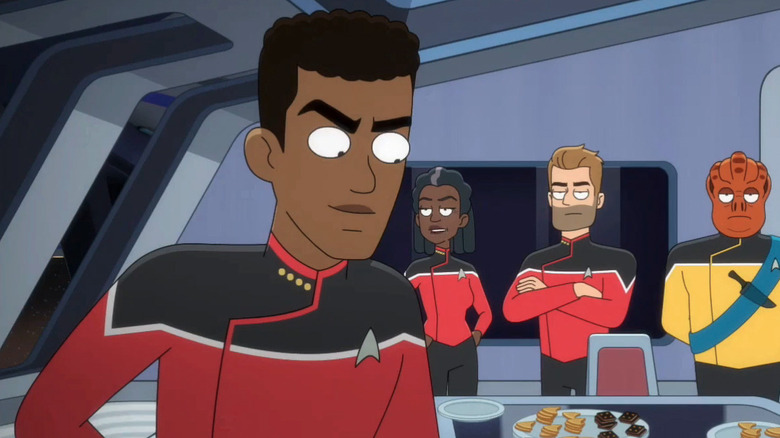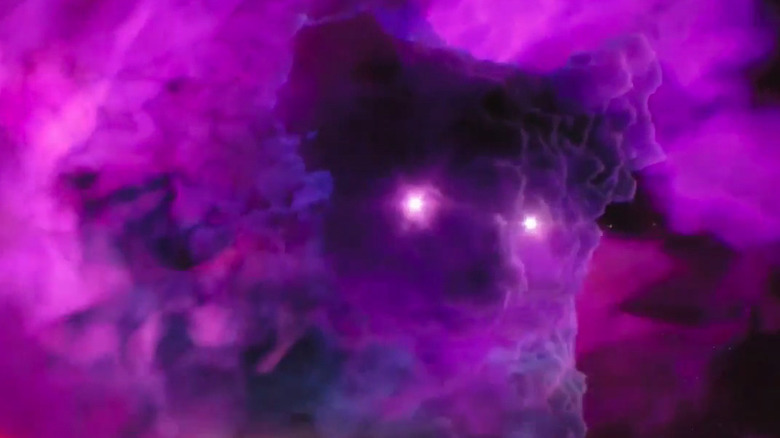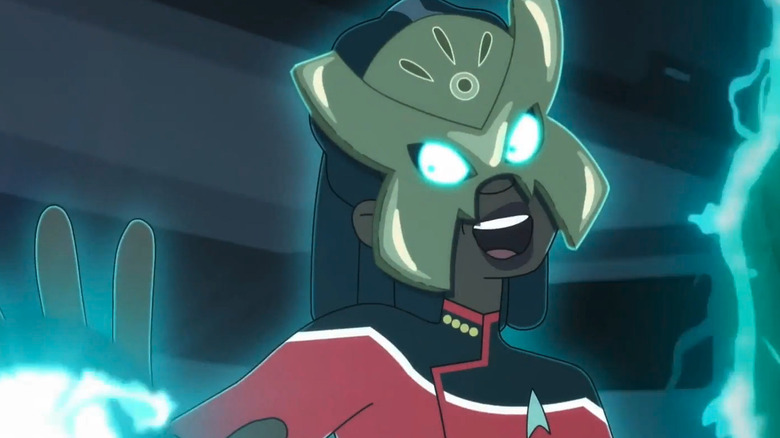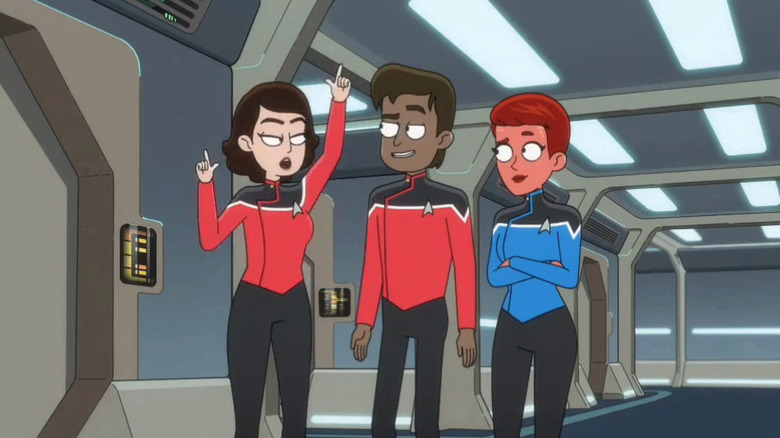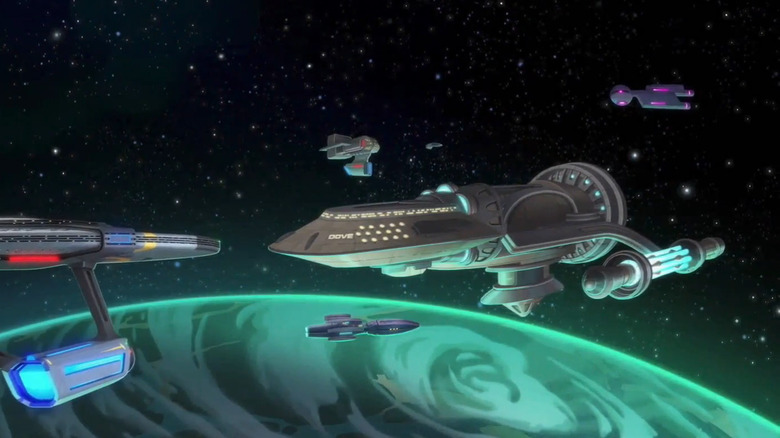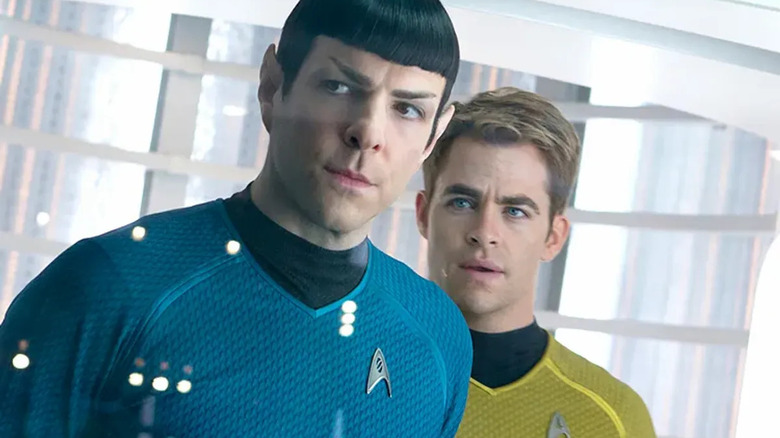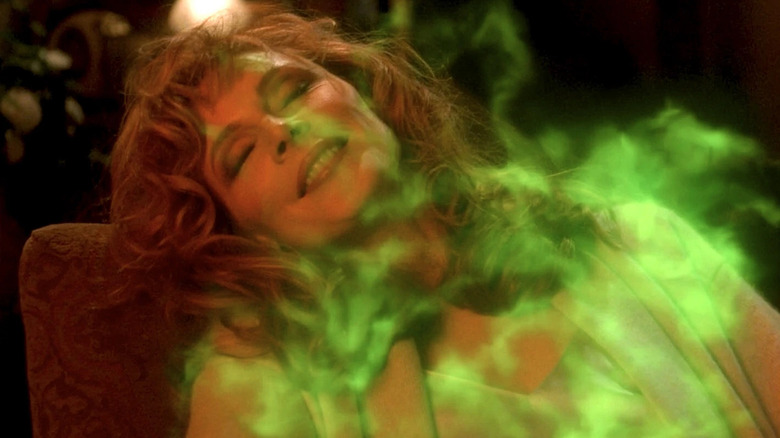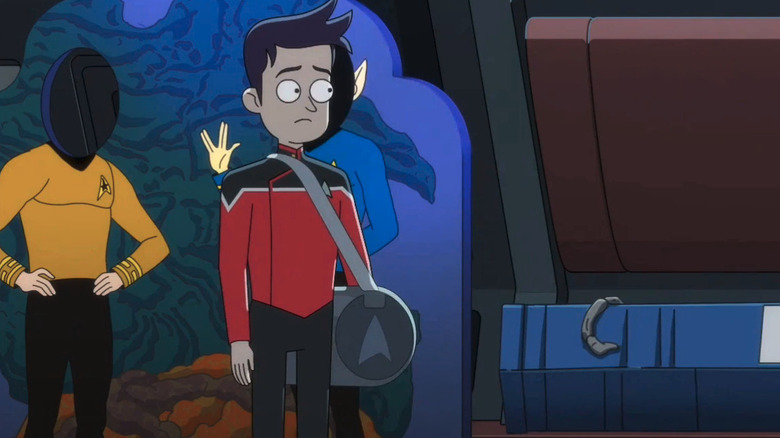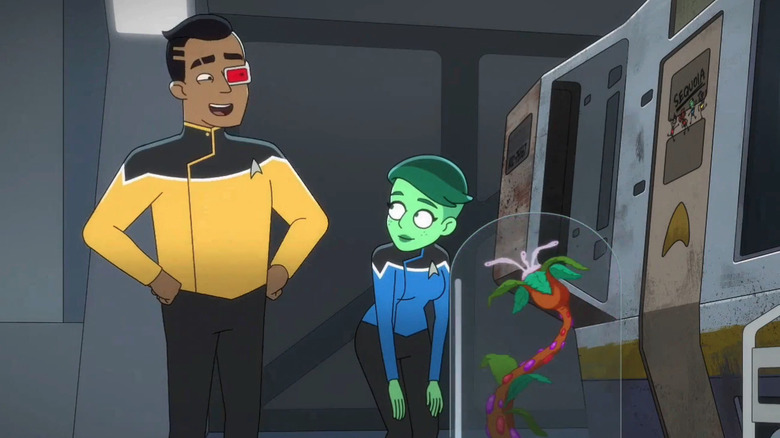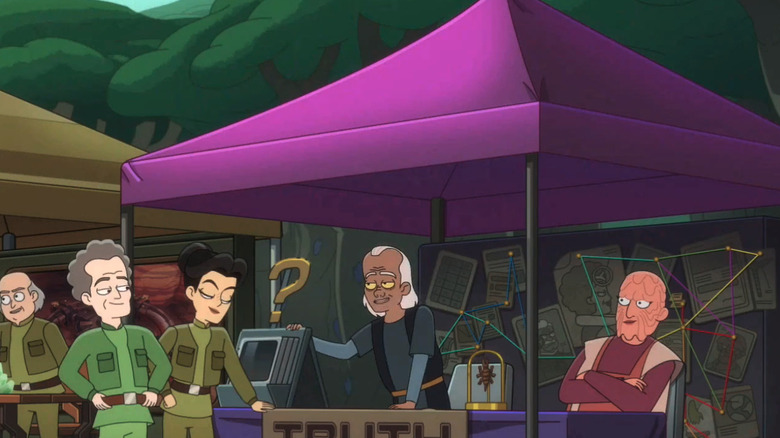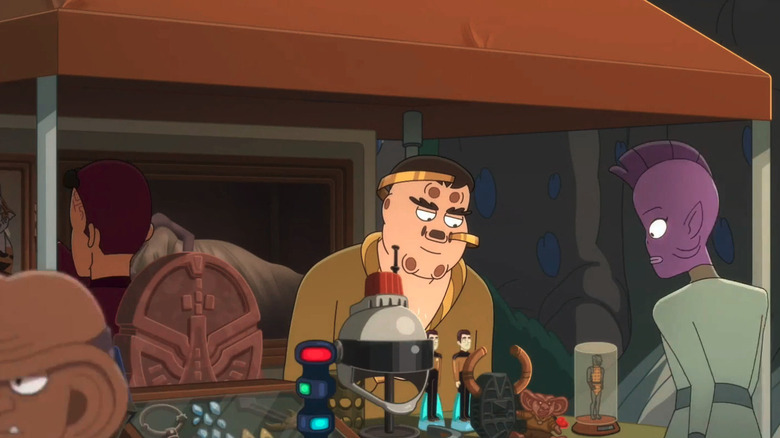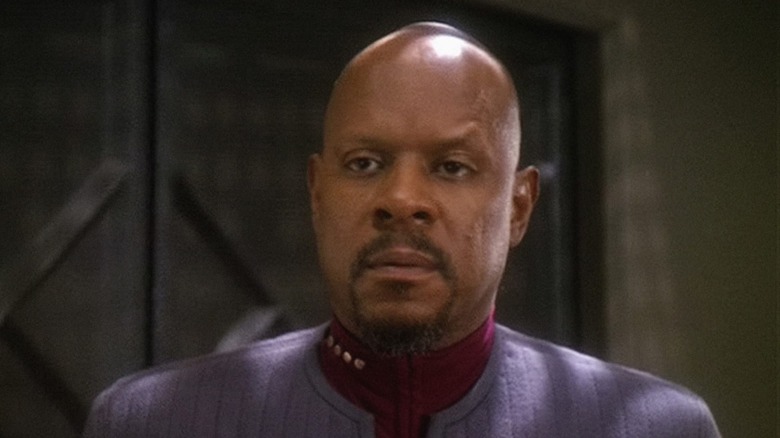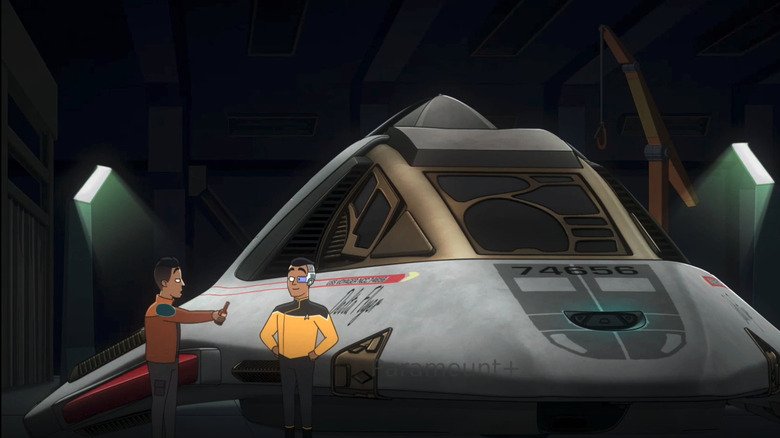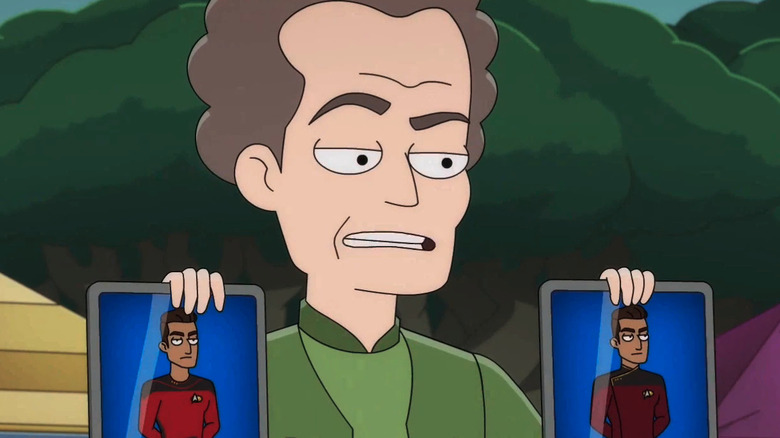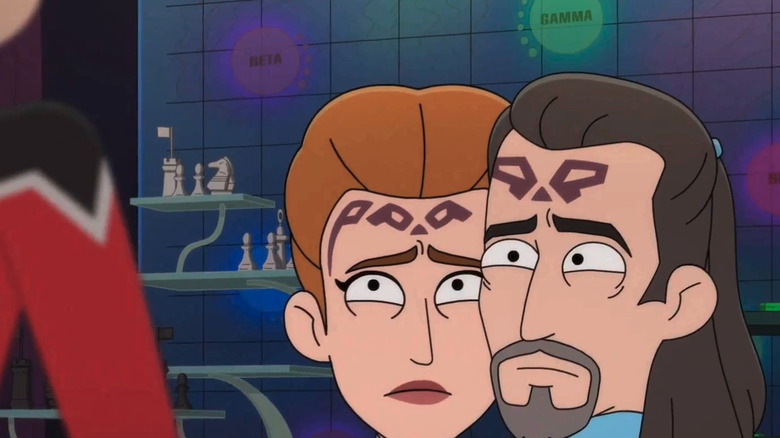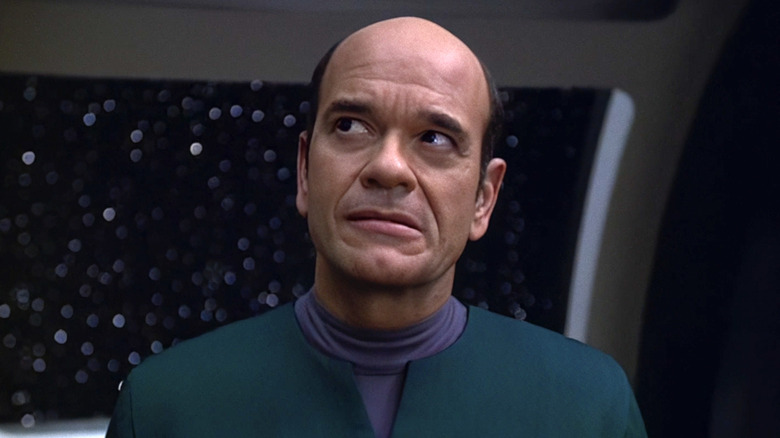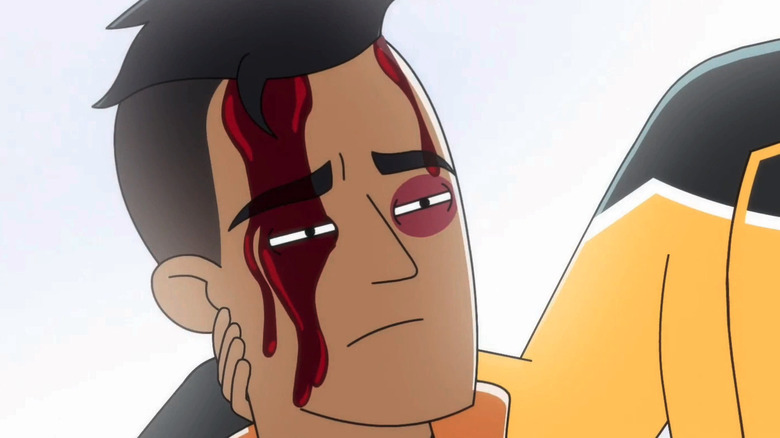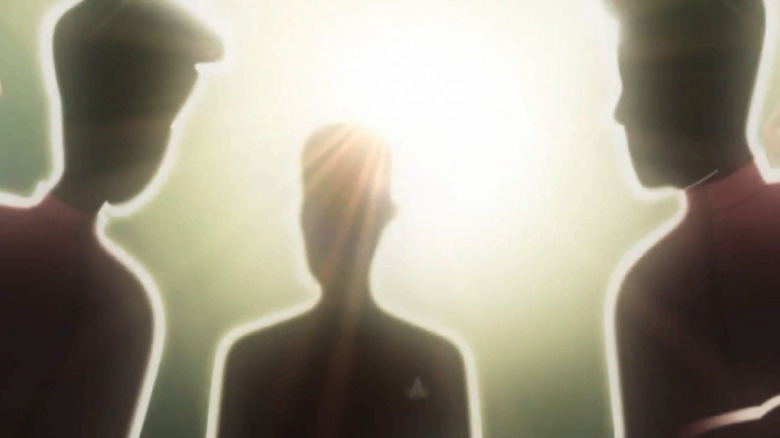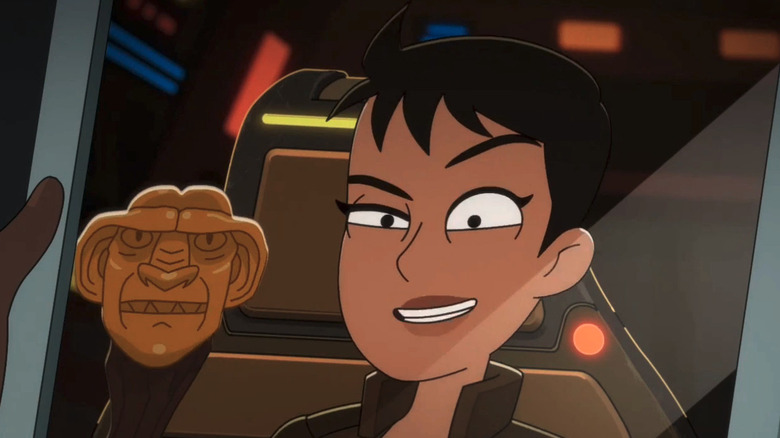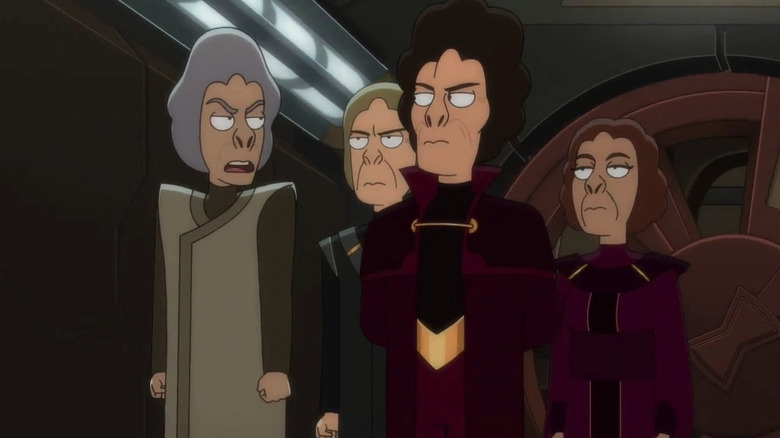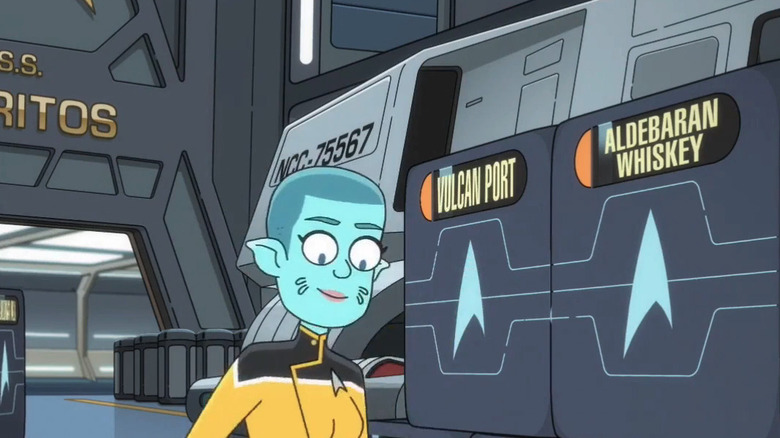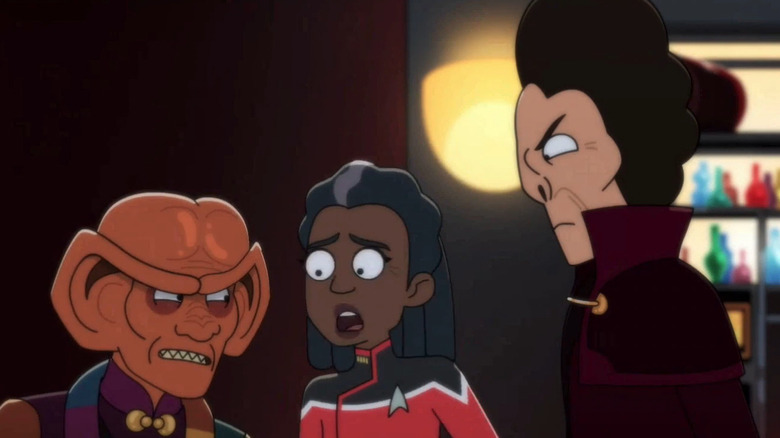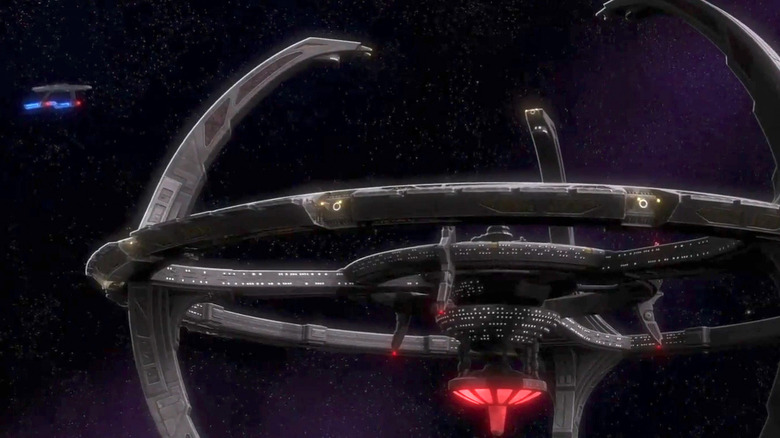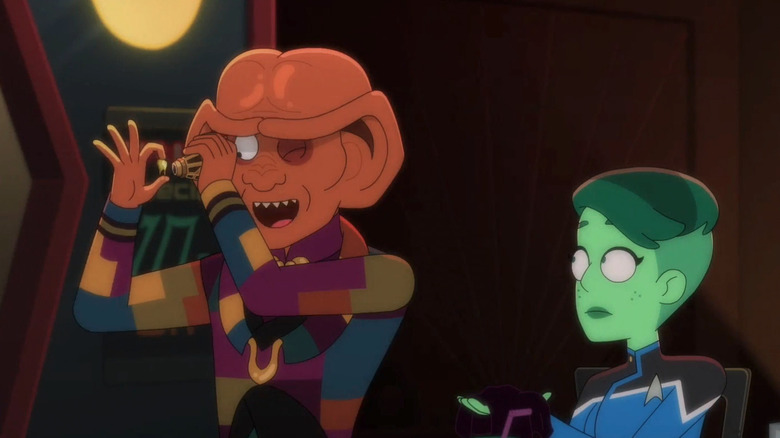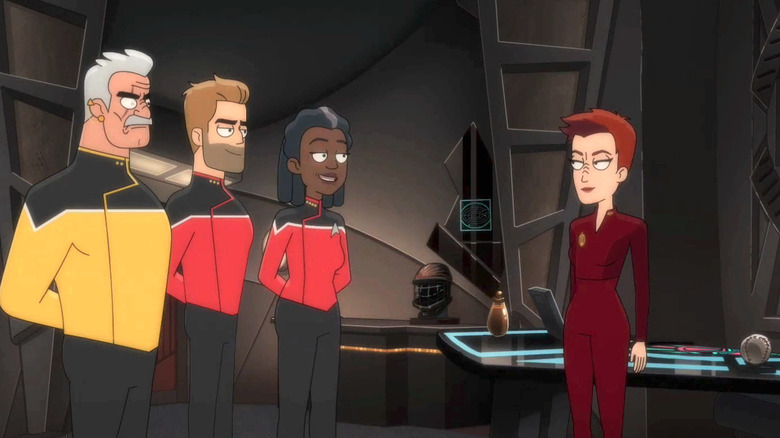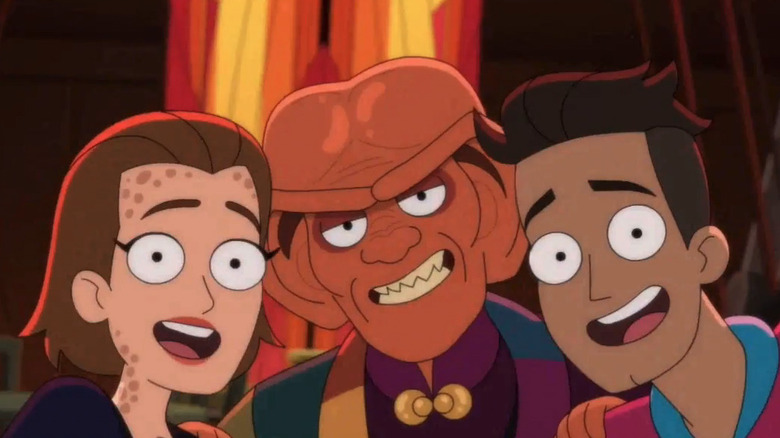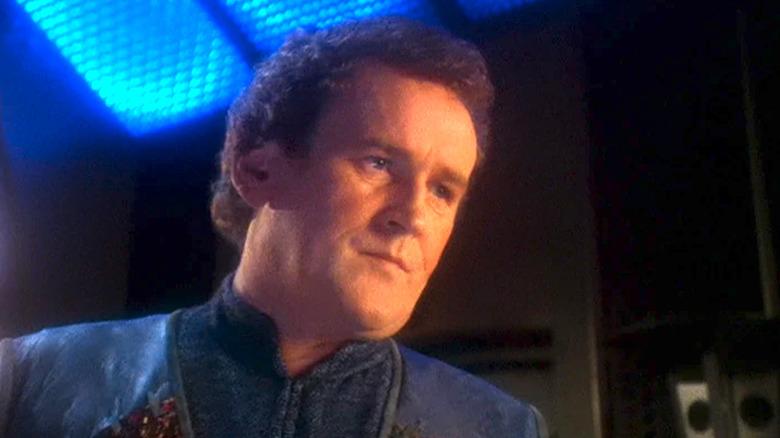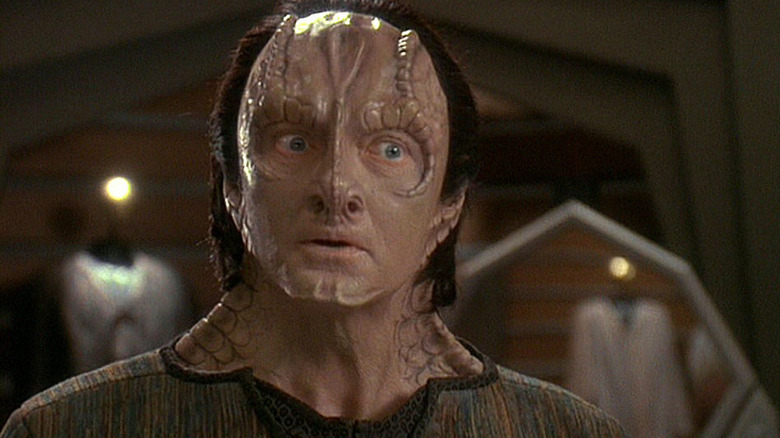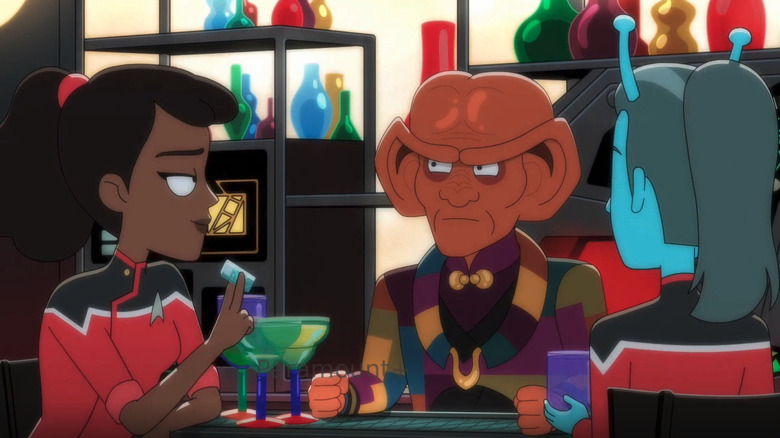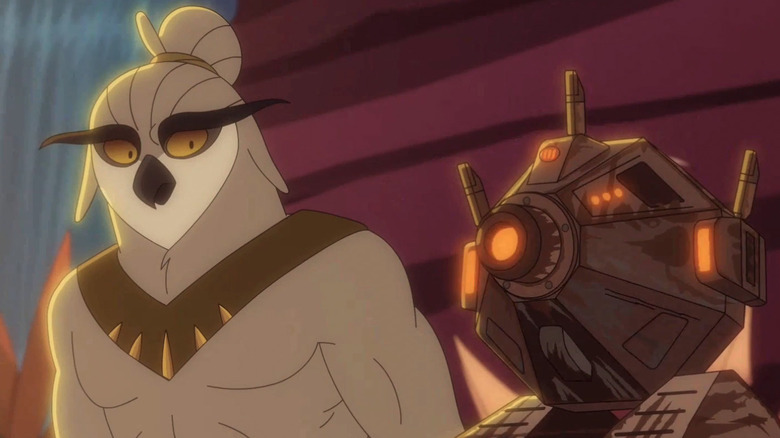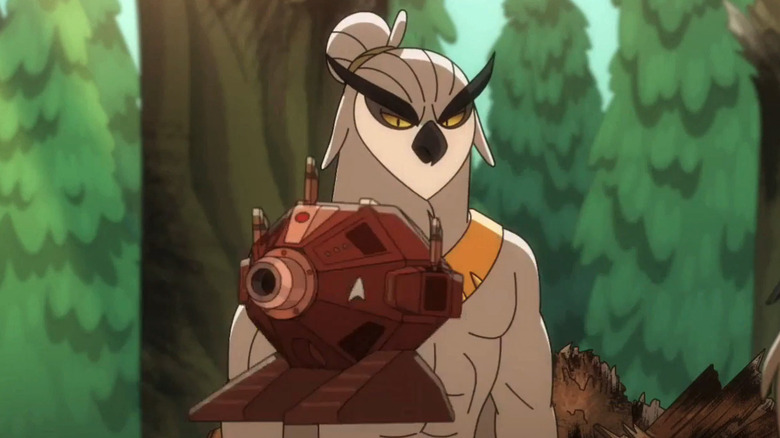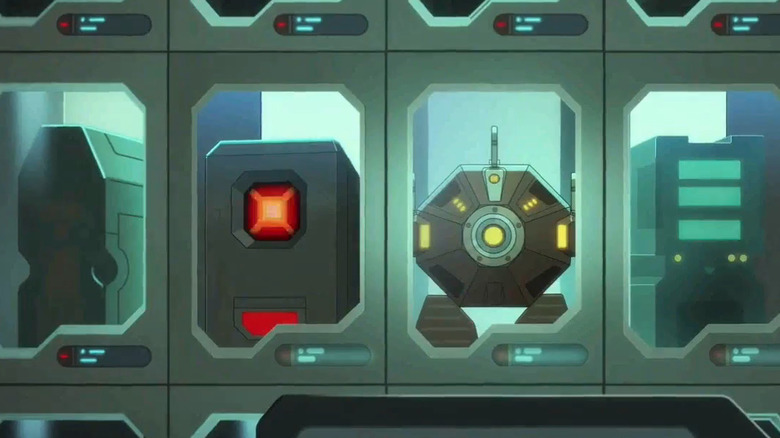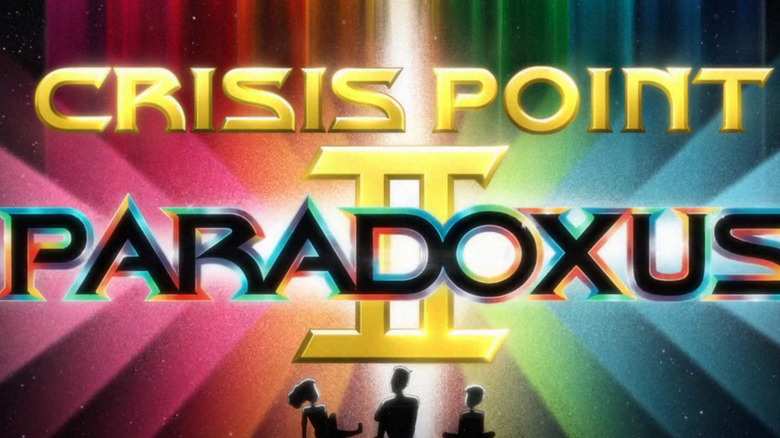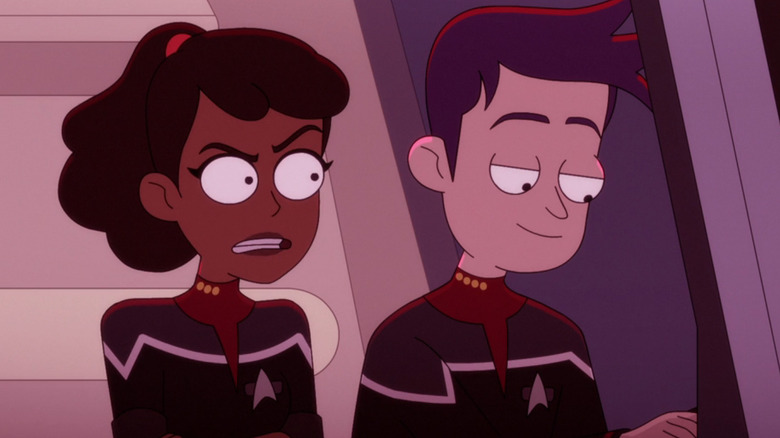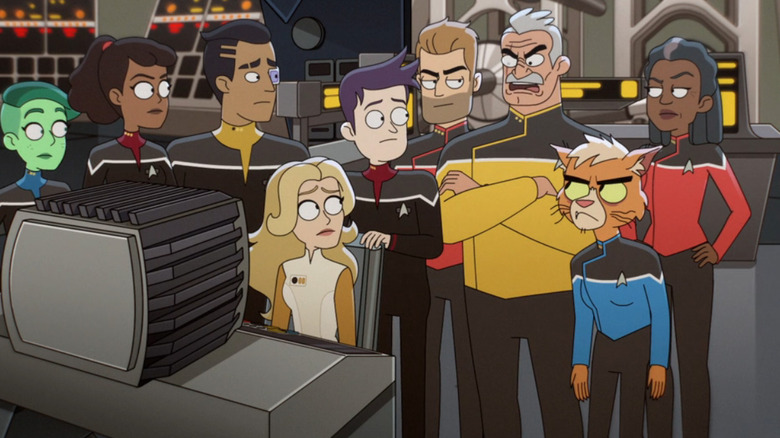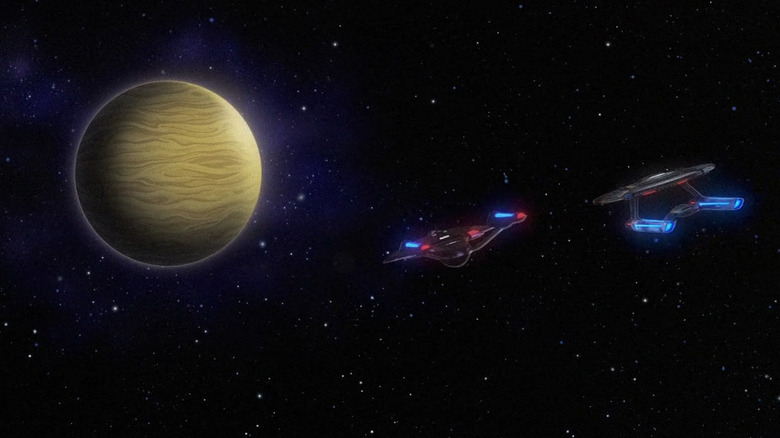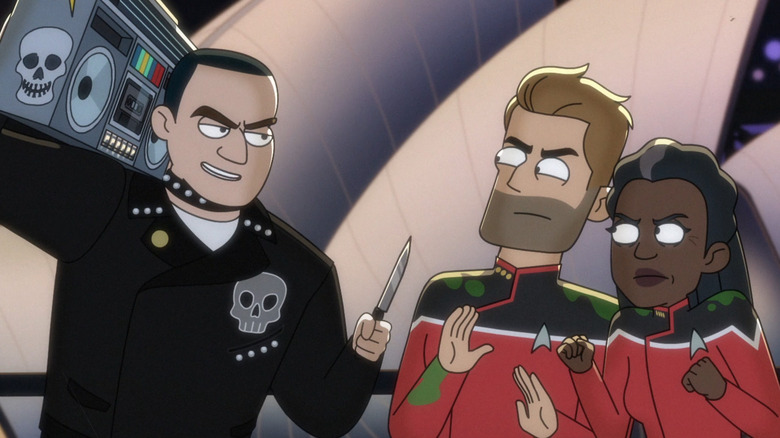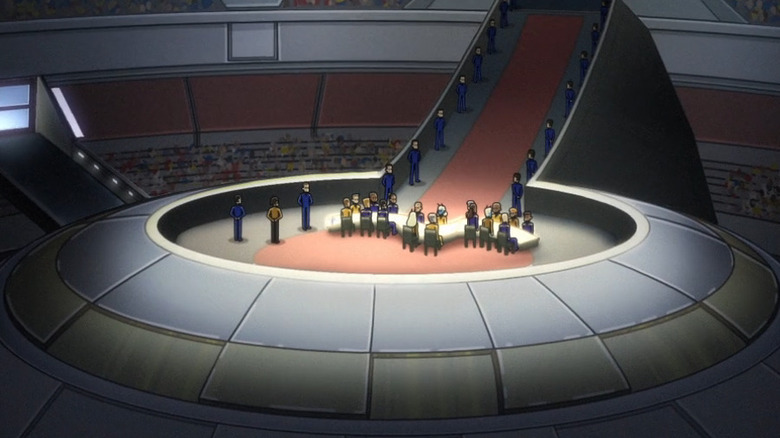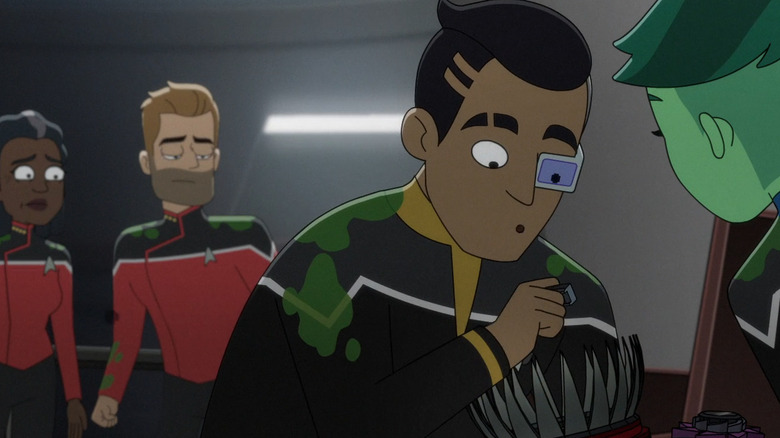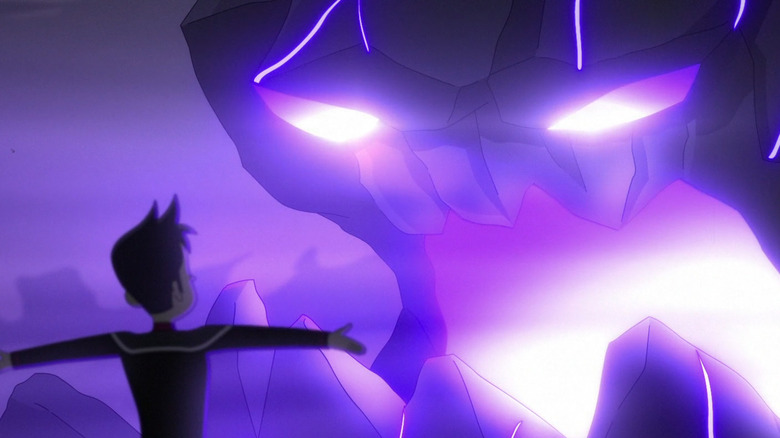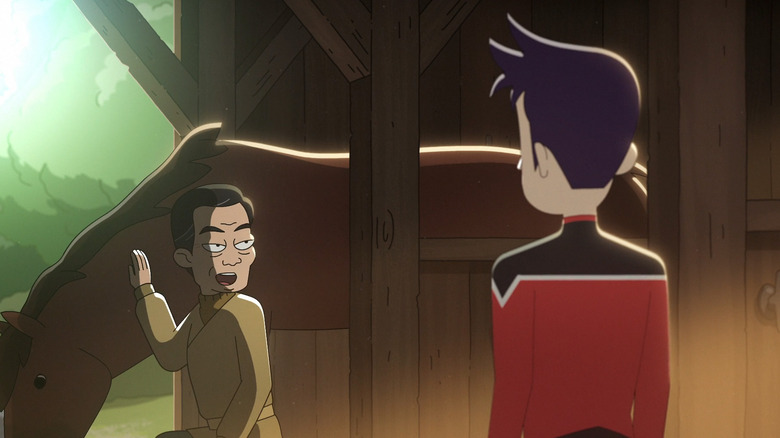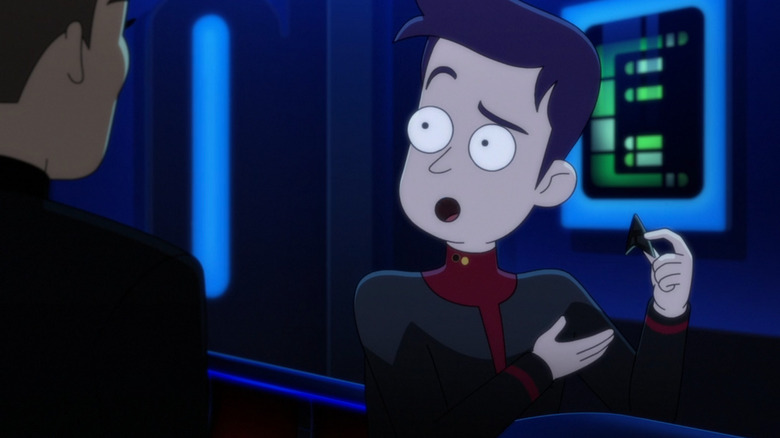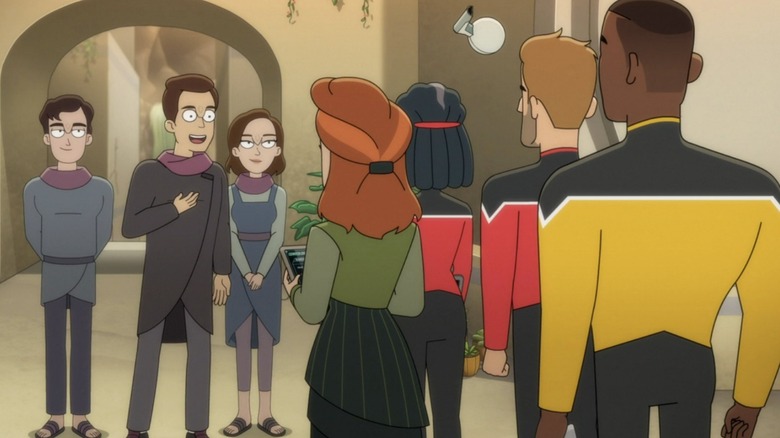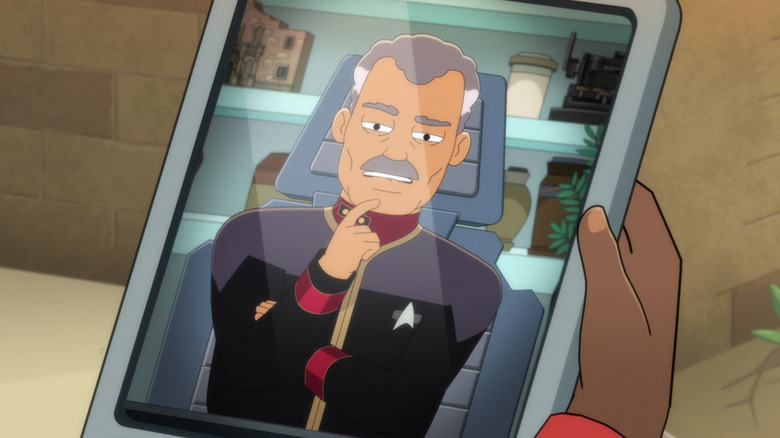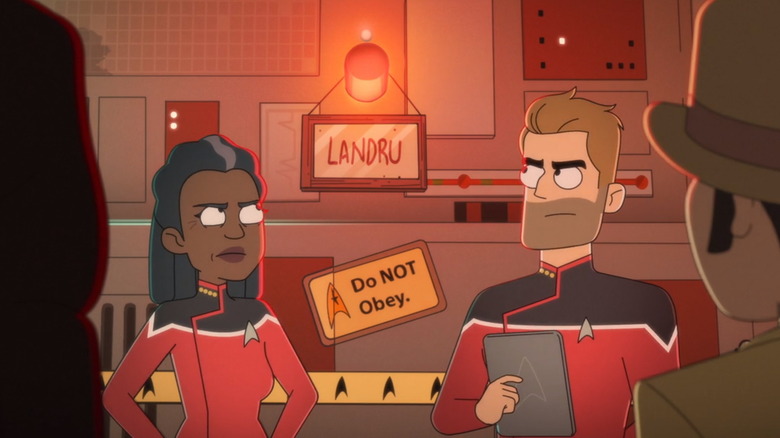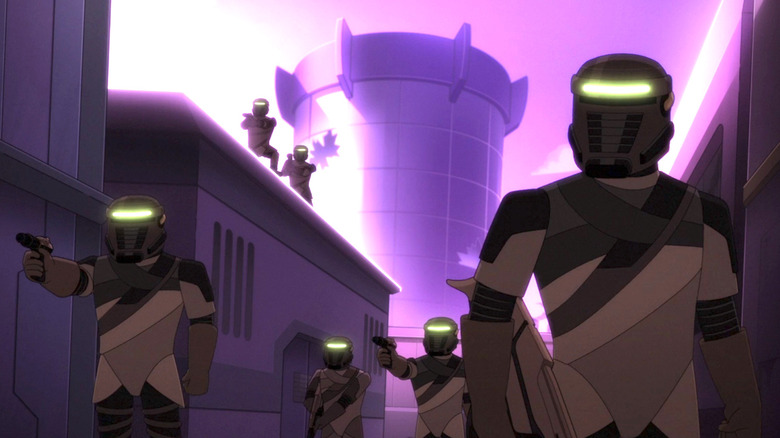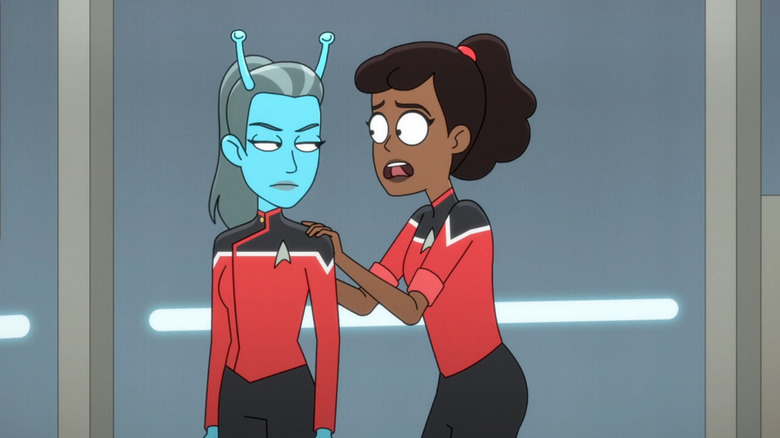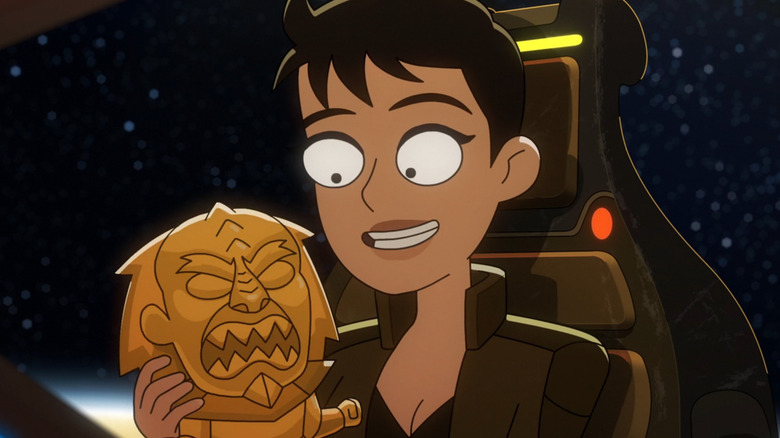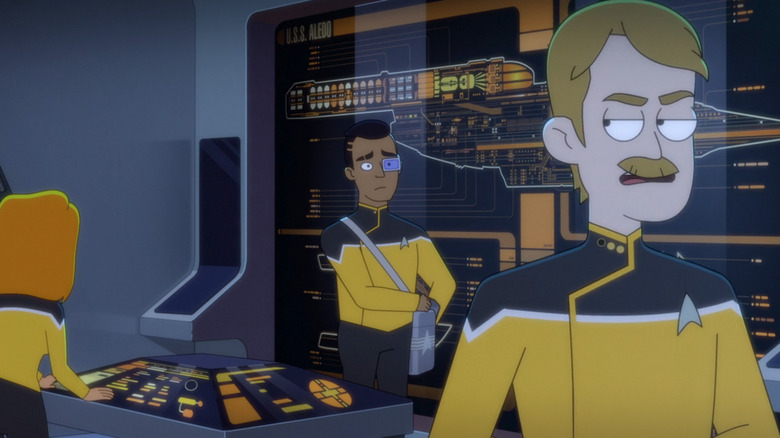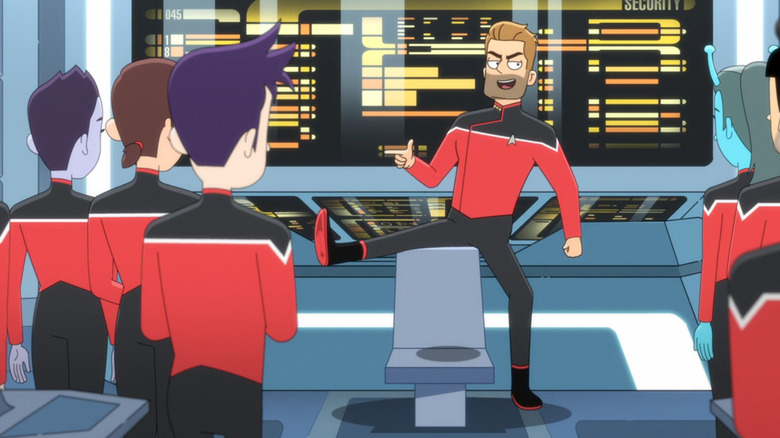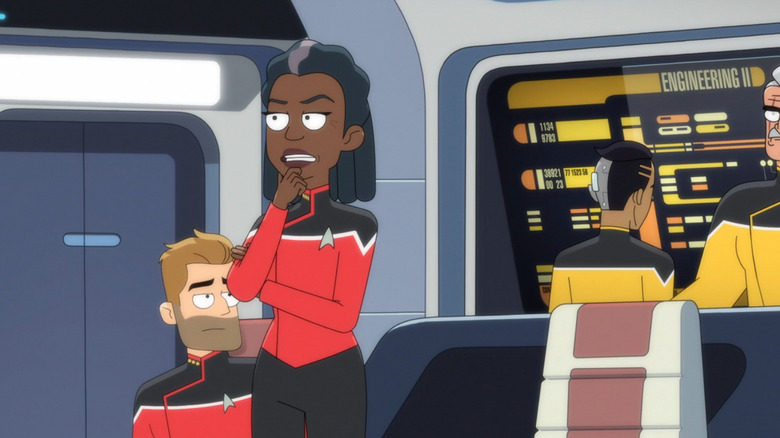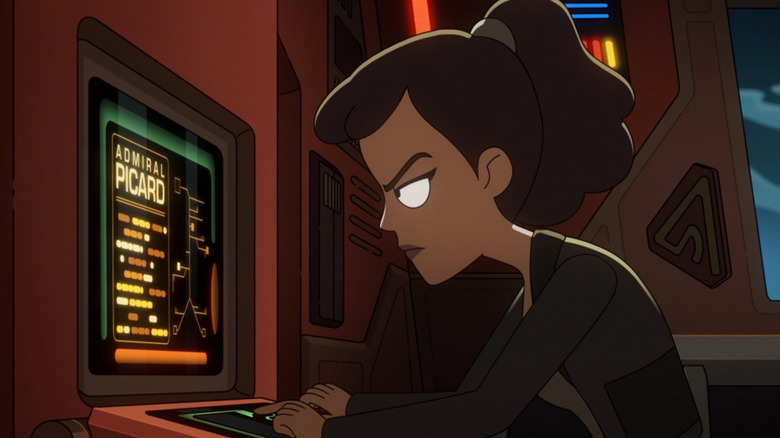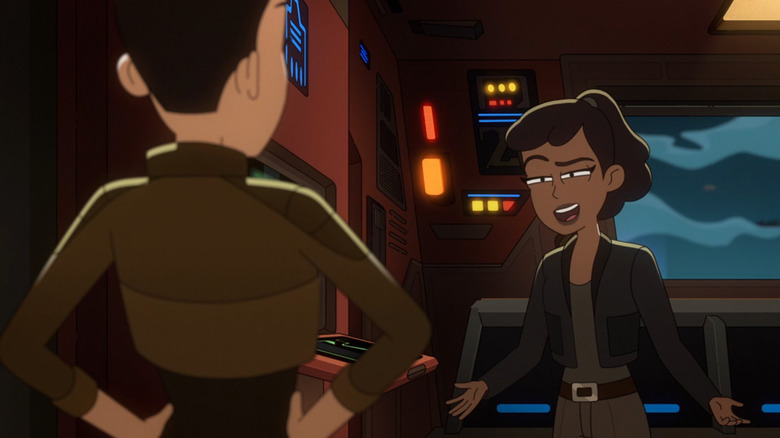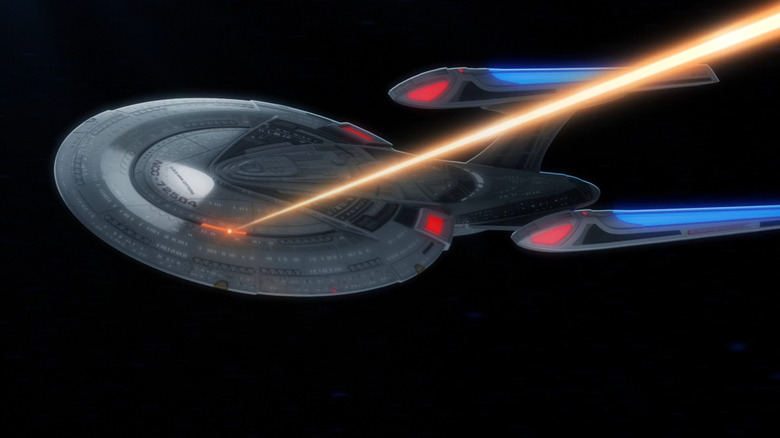Easter Eggs You Missed In Star Trek: Lower Decks Season 3
With two full seasons now under its belt, the animated adult comedy "Star Trek: Lower Decks" has proven to be a diehard Trekkie's dream, packed with callbacks and references to even the most obscure parts of the franchise's past. Thankfully, creator Mike McMahan, a former writer for "Rick and Morty," has shown he knows what he's doing and never lets the Easter eggs get in the way of a funny story. At its best, the show has used nods to old stories as a treat to longtime fans without distracting and throwing off newcomers.
Though Season 1 ends with a cliffhanger of sorts, "Lower Decks" Season 2 concludes with a real cliffhanger, as Captain Freeman is arrested and charged with the destruction of the Pakled homeworld. With no captain and the crew grounded, the series premiere picks up right where Season 2 leaves off; now it's up to Mariner, Boimler, Rutherford, and Tendi to get to the bottom of the allegations against their captain and hopefully set her free. All the while, the debut installment appropriately titled "Grounded" is itself full of Easter eggs. Its main plot — stealing the Cerritos from spacedock — is lifted from "Star Trek III: The Search for Spock."
But of course, that's not the only callback. So after you've watched every episode of Season 3, be sure to check back right here for the best Easter eggs you might have missed.
All the news that's fit for the Federation
Ever since "Deep Space Nine" we've known that the Federation has its own dedicated news service, with young Jake Sisko finding work as a journalist reporting on the Dominion War. But we got a more direct look at how current events are disseminated in-universe during the first season of "Star Trek: Picard" when the Federation News Network is seen on monitors across Earth and beyond. Admiral Picard himself even sits down for a televised interview on FNN in the series' first episode.
Now, "Lower Decks" has brought back the 24th-century news channel in its third season, as the premiere episode "Grounded" opens with news anchor Sylvia Ront providing a recap of the events seen in the shocking Season 2 finale. We see clips of the destruction of the Pakled planet and the accusations against Captain Freeman, with a quick summation of events to get viewers up to speed. The FNN logo first appears in the "Short Treks" episode "Children of Mars," hovering in the corner of the screen, just like any modern cable news network, while chyrons provide more news from across the Federation.
Jellico doesn't like fun
Though we don't get to see him on screen, another newsflash on FNN makes mention of one of the franchise's most polarizing captains — Edward Jellico, played by "RoboCop" and "Total Recall" star Ronny Cox. As seen in the "Next Generation" episodes "Chain of Command, Part I" and "Part II," Jellico is portrayed as a hardliner — a mean-spirited and bullheaded commanding officer who pushes the Enterprise crew around. Over the years, though, opinions about Jellico have been split, with some diehard Jelli-fanatics making a case that he may be the best captain in the fleet.
In the "Lower Decks" Season 3 premiere, we get word that Jellico is still around making life miserable for others and has been promoted to Admiral. An FNN news chyron informs us that the no-fun Jellico has banned the Zebulon Sisters — a duo of future entertainers mentioned in the "Lower Decks" episode "We'll Always Have Tom Paris" — from active-duty starships. In that episode, it's noted that the Zebulon Sisters have performed their famous Chu-Chu Dance aboard the USS Cerritos, but it doesn't sound like that's going to happen again any time soon ... at least not if Jellico has anything to say about it.
Baseball royalty
If we watch all the different news flashes seen in FNN chyrons, we get word that the "Buffalo Solar Knights eclipse London Kings in Game 1 of the ELDS." This is a deep-cut reference to episodes of "The Next Generation" and "Deep Space Nine" that note the state of baseball in the 24th century. In the "DS9" episode "If Wishes Were Horses" we learn that baseball died out in the 2040s, and the final World Series was played in 2042.
We also discover that one of the biggest teams in the game in those days was the London Kings, a member of the Planetary Baseball League as far back as 2019. The team's star shortstop, Buck Bokai (who apparently made his debut in 2015) eventually broke Joe DiMaggio's vaunted 56-game hitting streak in 2026.
It seems by the late 24th century, though, the sport has made a comeback — perhaps, in part, thanks to its popularity with legendary Federation Captain Benjamin Sisko — and that the Kings are once again contenders for a championship. Rutherford even suggests the "Lower Decks" gang take in a London Kings game themselves.
Strategema Jr.
Prior to "Lower Decks," Strategema was a fairly obscure game within the "Star Trek" universe. Though it made a rather prominent appearance in one episode of "Star Trek: The Next Generation" titled "Peak Performance," that second season entry is its lone mention in the franchise for more than 30 years.
In "Peak Performance," it's introduced as a game played by only the most skilled and disciplined minds, including a Zackdorn named Sirna Kolrami, who visits the Enterprise for a series of war games and apparently considers himself a Strategema grandmaster. Eventually, however, the android Commander Data plays him to a draw, and the Zackdorn strategist quits the game out of frustration.
In "Grounded," we learn that Zackdorns may be especially suited for the game, as a news flash tells us that a 6-year-old Zackdorn has just become the youngest ever official Strategema grandmaster. Could this be the child of a now-retired Kolrami? That remains to be seen.
Clemonds makes a comeback
A lot of information flashes across the FNN chyrons, and our last bit of breaking Federation news relates to a character "Trek" fans have been wondering about since 1987. In "The Next Generation" episode "The Neutral Zone," which also happens to be the Season 1 finale, we met L.Q. "Sonny" Clemonds. One of three individuals who entered suspended animation in 1994 when medical science couldn't cure their terminal ailments, the revived Clemonds is a guitar-playing Southern country music man.
Unlike his two 20th century compatriots, however, he's perfectly happy with his new life 300 years after everything and everyone he once knew. In fact, he hopes to return to his musical career. According to FNN in "Lower Decks," that's exactly what happens, though not without some unintended consequences. While anchorwoman Sylvia Font talks about the status of the Cerritos in spacedock, we see a news headline informing viewers of a tragedy at a Sonny Clemonds concert. According to the chyron, a dozen teenage fans were injured in a stampede after a crowd rushed the stage. Hopefully, nobody had to be cryogenically frozen to await treatment.
Hoisted with his own Picard
With Captain Freeman looking at serious charges, her daughter Ensign Mariner sets out to assemble the Cerritos gang to help clear the captain's name. On Earth, her first task is to recruit Ensign Boimler, who is working in his family's vineyard. One of the gags here is that the Boimler family vineyard is used for making raisins, not much more exciting wine. Another running gag is all the women have the hots for Boimler, and the purple-haired ensign sports a look that calls back to the "Next Generation" finale "All Good Things."
In the future segments of that epic series capper, an elderly Picard wears a get-up identical to what we see here, complete with a wide-brimmed straw hat, brown overalls, and a diagonally cut tunic. Though it's not made clear if this is the 24th-century vineyard uniform, it's a nice nod to one of the franchise's best episodes.
Guess who's coming to dinner?
Once Mariner has Boimler on board with her plan to fight for her mother's innocence, they need to find the Cerritos, which is in a secure spacedock. To help locate it, they'll need Ensign Rutherford, one of the few engineers who may have been kept aboard to dock the ship and might know where it is. When they find him, he's out to dinner at a famous "Star Trek" locale, a legendary Earth restaurant called Sisko's Creole Kitchen.
Not just a nod to the "Deep Space Nine" Captain Benjamin Sisko, the restaurant is an in-universe Earth eatery that we've seen before. In fact, Sisko's made its first on-screen appearance in a pair of episodes in Season 4 of "DS9." Owned by Ben Sisko's father Joseph Sisko, it's been around for decades, and Captain Sisko himself practically grew up in the restaurant. The "Lower Decks" premiere "Grounded" is the first time we've seen it since 1999 when it showed up in the final season of "DS9."
In this episode, the restaurant is identical to its previous appearance, as the animation team evidently did a perfect job recreating its facade and interior. We even get a look at the alligator hanging from the ceiling mentioned in the "DS9" episode "Homefront."
Jem'Hadar heat
Creole food, the cuisine of choice at Sisko's, is definitely known for spices and intense heat, and we learn just how hot things can get in "Grounded." Sitting down for some chow in Sisko's Creole Kitchen, the four ensigns partake in some of the restaurant's specialties. During this scene, Boimler reaches for a bottle of hot sauce called Ketracel White Hot. That's an Easter egg that any true "Trek" fan should recognize, as Ketracel White is the addictive compound that fuels the Jem'Hadar soldiers in the Dominion.
It was said in "Deep Space Nine" that Ketracel White was crafted by the Founders as a way of maintaining an additional level of control over the Jem'Hadar, as the soldiers could not live without regular doses of the drug. Here, however, we suspect Sisko's isn't using a sauce with the actual Ketracel White; they're just using the name for the latest Creole condiment blend.
First contact theme park
Needing a way to get to the Cerritos with all of Earth's transporters down, Mariner and the crew set out to visit Historical Bozeman, where they hope to commandeer a ship designed to be an orbital kids' ride. Based in Bozeman, Montana, at the site of human's first contact with the Vulcans, the site is one giant reference to the 1996 film "Star Trek: First Contact."
We could write an entire article on the Easter eggs seen in the park, including the statue of Zefram Cochrane referenced by Geordi in the film and the various musical cues taken from the movie.
Balloon animals at the park are shaped like the Enterprise, the USS Defiant from "Deep Space Nine," and the Vulcan landing craft from "First Contact." Tendi points out the Crash N' Burn Bar, which appears to be the same joint where Riker and Troi first meet Cochrane, as well as a "First Contact Fun Zone" constructed to look like a Vulcan ship.
James, big in the city
Of course, the centerpiece of Historical Bozeman is the Phoenix, a replica of the ship used by Zefram Cochrane to test mankind's first ever warp drive. Here it's a kiddie ride, but is nevertheless a functioning starship, and Mariner and the crew plan to steal it and take it to the Cerritos.
But once aboard, they meet a holographic pilot fashioned after Cochrane himself. In a guest-starring role, the holo-Cochrane is voiced by none other than the legendary James Cromwell, who played him in "First Contact." This is the first time Cromwell has played the character since a brief cameo in the series premiere of "Star Trek: Enterprise" back in 2001. While preparing for the flight, Cochrane gives a two-fingered salute, a nod to Captain Picard's identical "engage" gesture from "The Next Generation."
But before holo-Cochrane takes the ship out, he makes sure to "rock n' roll" and puts a little green disc into the ship's computer, and we hear the thunderous roar of Steppenwolf's "Magic Carpet Ride." This is no new gag though, as it mirrors a scene in "First Contact" when the real Cochrane did the same thing in one of the movie's funniest moments.
An all-star Starfleet team
After a rather complicated plan to free her mother proved fruitless, it's all revealed to have been unnecessary, as it turns out that Starfleet has already cleared Captain Freeman of all charges. During her trial, a covert ops mission led by Captain Morgan Bateson is undertaken to investigate the allegations against her. Fans will know that name, even if it's been a while, as he was seen briefly at the conclusion of the "Next Generation" fifth season episode "Cause and Effect," played by "Cheers" star Kelsey Grammer.
Bateson is a Starfleet captain from the 23rd century who spends nearly 75 years in a causality loop and emerges in Picard's time. For the first time in canon, we learn that Bateson has returned to his captain's duties in the 24th century, and is joined on this mission by Commander Tuvok, security chief of the starship Voyager. In the flashback to their mission, "Grounded" shows both officers in the "DS9" style Starfleet grays, the first time both characters have been seen in that uniform.
Martok: The Interactive Video Game
In the cold open for the second episode of Season 3, titled "The Least Dangerous Game," we see Boimler, Tendi, Rutherford, and Mariner playing a 24th century tabletop miniatures game. But this is no simple game played with ordinary gaming pieces, as it also contains an iPad-like screen with an interactive host. Whether intentionally or not, the video segments of the game are reminiscent of an actual game produced in the 1990s – "Star Trek: The Next Generation Interactive VCR Board Game" which used a VHS tape that included pre-recorded segments of Klingon Chancellor Gowron (Robert O'Reilly) helping players through the game.
Here, the host is a different Klingon Chancellor — Martok, a famed Klingon fleet commander and one of the most popular recurring characters on "Star Trek: Deep Space Nine." Rutherford notes that Martok is still chancellor of the Klingon Empire, just as he is in the finale of "DS9." While it's said that it's not actually Martok voicing him for the in-universe game — instead it's a Ferengi knock-off — the character is indeed voiced by actor J.G. Hertzler, who played the general previously.
Though is the first time we've seen Martok in canon since 1999, not counting his skull in an episode of "Picard," Hertzler has ironically voiced the character numerous times in a number of video games over the years.
Orbital lift-me-up
Following the events of "Grounded," Ensign Mariner is under the direct command of first officer Ransom. The Cerritos commander takes Mariner on a mission to an alien world where transporters cannot operate. As a result, the civilization there has built a series of orbital lifts to ferry people from orbit to the surface. Since they've broken down, the Cerritos has arrived to help repair them. The orbital lift system, of course, should ring alarm bells for Trekkies as the concept has been seen once before — in the "Star Trek: Voyager" episode "Rise," in which Neelix and Tuvok get stuck aboard another malfunctioning lift.
But this Easter egg is about more than just that one episode of "Voyager," as the look of the lift's terminus is a clear nod to the first J.J. Abrams' "Star Trek" film. The top of the lift is designed and based on the look of the Romulan mining platforms seen in that movie. It's definitely not a coincidence as, later in the episode, the lift plays a key part in a clear reference to a famous sequence from 2009's "Star Trek."
Springy balls
The central plot for Ensign Boimler in "The Least Dangerous Game" is his attempt to leave his comfort zone after learning that another officer has recently been made captain. He decides to take opportunities that he might not normally consider, like when he's invited to play a game of springball with some of the ship's senior crew members, who are looking for somebody wiry and hard to hit. Volunteering pays off, as Boimler's sustained screaming impresses Commander Shaxs enough to earn an invite to perform in a choir, which in turn earns him a debt from the ship's security officer.
But the game of springball wasn't invented just for this gag; in fact, it has its roots in "Deep Space Nine." It's mentioned numerous times as a sport played by several members of the "DS9" crew, including Bashir, Chief O'Brien, and Major Kira, who we even see playing in a big game in the episode "For the Cause." In "The Least Dangerous Game," the attention to detail is on point, with the uniforms, racquets, and the springball court itself all identical to those seen in "DS9."
He is Tosk
Now that the new and improved Boimler has decided to start saying "yes" to any new opportunity, he's given no choice but to agree to a proposal made by a visiting alien. The alien in question, called K'Ranch, is a monstrous beast who has an undeniable urge to hunt people for sport. But with the orbital lifts inoperative, K'Ranch is unable to get to the surface of the planet for his next hunt and needs someone to step in. So, when he asks Boimler to be his prey, Boimler responds in the affirmative.
From the sound of the scenario, it seems that K'Ranch is an homage to yet another episode of "Deep Space Nine" — the Season 1 episode "Captive Pursuit." In that episode, a being known only as Tosk comes aboard the station, and it is eventually learned that Tosk is ritualistic prey for an alien species. In fact, the name "Tosk," it's said, literally translates to "The Hunted."
Series creator Mike McMahan confirmed the inspiration in an interview with Screen Rant, telling the outlet that "K'Ranch is a Kromsapiod. He is partially based on one of my favorite 'Deep Space Nine' species, Tosk. ... and I love when Tosk shows up and is like, 'Somebody hunt me? Somebody hunt me!' And they're all like, 'No.' And O'Brien is kind of like, 'I think we should hunt him.'" No hesitation here however, as Boimler seems more than happy to be hunted.
Starfleet drop out
With the orbital lift platform designed to pay homage to a key scene in the 2009 "Star Trek" film, it should come as no surprise that a major sequence in "The Least Dangerous Game" directly patterns itself after a moment in that movie. It all happens when Ensign Mariner grows frustrated with Ransom's unwillingness to go down to the planet's surface to help Rutherford, so she sneaks off to save the day against orders. Donning an environmental suit that's been designed for freefall — parachute and all — Mariner leaps from the platform in an effort to get to the planet in the same manner that Kirk, Sulu, and Olson do in 2009's "Star Trek."
At the last moment, Mariner gets word from Ransom that he's decided to go down to the planet after all, and she aborts her drop and activates her parachute at the last second, just as the trio do in the film. Thankfully, unlike Olson, she isn't sucked into any open flames and killed instantly. Instead, she manages to make it back to Ransom, and he's never the wiser that she defied his orders.
Friends of Murakami
The third episode of "Lower Decks'" Season 3 is titled "Mining the Mind's Mines" and begins with Captain Freeman's log where she announces their arrival at the planet Jengus IV. The Cerritos is there along with her sister ship, the USS Carlsbad, as the Federation has just completed diplomatic negotiations with the race of rock people who reside there. The negotiations were carried about by Captain Murakami of the USS Hood, a ship with deep roots in "Star Trek" lore.
First mentioned all the way back in the premiere episode of "Star Trek: The Next Generation," this is the ship that dropped off newly installed first officer William Riker to the USS Enterprise-D. Riker had served on the Hood previously as its first officer under Captain DeSoto, who himself appeared in the episode "Tin Man." The USS Hood was mentioned many times throughout "TNG" and the spinoff "Star Trek: Deep Space Nine," as it eventually went on to serve on the front lines of the Dominion War. A popular ship with fans, the Hood and Captain DeSoto inspired the phrase "Friends of DeSoto," as a question to ask suspected fellow listeners of the long-running "Trek" podcast, "The Greatest Generation."
In "Lower Decks" is set just a few years after the Hood returns in "TNG," but seeing as the Hood has a new captain, it seems likely that DeSoto was promoted after a long tenure.
Spock, the writer
In a subplot in "Mining the Mind's Mines," Ensign Tendi is undergoing science officer command training and has been matched up with a mentor. Unfortunately, her mentor turns out to be Dr. Migleemo, a green bird person who Ensign Mariner once called "the worst counselor in the fleet." As she runs through some of what they'll be working on, Migleemo pulls out a PADD with a Starfleet Science Officer Training Manual penned by Federation legend Spock. This moment carries on the idea that Spock became a writer after serving in Starfleet, as it isn't the only time we've seen him play author. In a Season 2 episode of "Star Trek: The Next Generation," Picard introduces a book given to Romulan cadet Elnor titled "The Many and the One," a memoir also written by the legendary former Enterprise science officer.
Scrolling through its contents, Ensign Tendi is impressed by Ambassador Spock's foreword. At this point in the timeline, Leonard Nimoy's indispensable character is likely still on Romulus, where we last saw him at the conclusion of the "Next Generation" episode "Unification, Part II." Migleemo notes that Spock's "Vulcan stuff" is a little long-winded, mentioning that "It would have been logical to get an editor." She also says that according to Spock, being a commander in Science Division is less about tests and "more about learning to be the voice of science."
An animated nightmare
On Jengus IV, the crews of both the Cerritos and the Carlsbad arrive in the aftermath of Federation negotiations. It seems a Federation outpost on the planet was under the impression the world was uninhabited, but now that they know it's not, the outpost requires relocation off the planet. But when they get to the surface, one of their tasks is to remove the psychic mines that surround the outpost. These telepathic booby traps take the form of glowing green orbs that read minds and can bring a person's wildest fantasies to life.
During their mission, a number of these orbs cause dangerous creatures of all kinds to materialize, including a giant Borg snake and clown-faced Klingons with bat'leths for arms. But in one of the deepest cuts so far in Season 3, the psychic minds deploy a Kukulkan, a colorful flying serpent with a pink unicorn horn and bright blue wings. These creatures have only been seen once before — in "How Sharper Than a Serpent's Tooth," a 1974 episode of the short-lived "Star Trek: The Animated Series."
An alien creature that visits Earth in the ancient past, the Kukulkan helps influence numerous human cultures like the Egyptians, Mayans, and Aztecs. It's a key part of these early civilizations' technological achievements and is also proof of just how bizarre the 1970s animated series really is.
Virtual Leah Brahms
The Kukulkan isn't the only being brought to life by the psychic mines, of course, as each member of the Cerritos' away team is ultimately affected by these strategic delusions. For Ensign Mariner, it's a seductive version of her girlfriend, fellow crewmate Ensign Sh'reyan; meanwhile, Boimler is tempted by a Starfleet Admiral who claims to need his "Boimler magic" for mission to stop the Borg. But it's the vision induced by Ensign Rutherford that provides the episode's best Easter egg by introducing us to Leah Brahms, Starfleet's preeminent warp field theorist.
Actor Susan Gibney reprises her role as Brahms, a character we've seen twice before. "Mining the Mind's Mines" isn't the first time a crew member has developed a crush on a recreation of Brahms; Geordi La Forge conjures a virtual Brahms in the holodeck as an assistant in the "Next Generation" episode "Booby Trap" and just like Rutherford, falls in love with her. We eventually meet the real Brahms in a follow-up episode of "TNG" titled "Galaxy's Child" where she discovers Geordi's holodeck program of her and things get awkward. Hopefully, she doesn't find out about Rutherford's imaginary recreation this time.
Ship of the line
Meeting with the command crew of the USS Carlsbad, Captain Freeman encounters her sister ship's captain for the first time. A young, upstart officer named Captain Mayer, Freeman remarks that he's so young and fresh-faced that she wonders if he just graduated Starfleet Academy yesterday. "I don't know," Commander Ransom responds. "But word around the Fleet is that he's on the fast track to a Galaxy class."
The most famous Galaxy class is, of course, the USS Enterprise-D, the ship captained by Jean-Luc Picard in "Star Trek: The Next Generation." Only a few ships of this class have been seen outside of the Enterprise, including the USS Yamato in the "TNG" episode "Contagion," and the USS Odyssey in the "DS9" episode "The Jem'Hadar." At the time that "Lower Decks" is set, the Galaxy-class Enterprise is gone, having been destroyed a few years earlier in the film "Generations" and replaced by the more advanced Sovereign-class USS Enterprise.
Despite the fact that it's been supplanted by more advanced classes, it seems from the way Ransom refers to it that the Galaxy class may still be among the most prestigious ship in the fleet.
The secret origin of the universe
If you're looking for clever callbacks, look no further than the koala at the end of the universe. In "Mining the Mind's Mine" the crew completes their mission after a harrowing firefight with villains from their own imaginations. When they get back to the Cerritos, a severely injured Stevens is in the lounge sporting casts on both of his arms. Attempting to flirt with a Vulcan officer, he raises a glass and recounts his recovery and a conversation he had with the ship's doctor, saying, "Okay doc, but if I was braindead for 10 minutes, how come I saw a koala sitting on a black box?"
The mention of a koala ironically indicates that Stevens was, in fact, dead, as we've heard mention of this phenomenon before. This ongoing gag started in the Season 1 episode "Moist Vessel" where O'Connor ascends to another state of consciousness and notes that he can see the entire universe is balanced on the back of a cosmic koala. The gag makes a comeback in "First First Contact" in Season 2 when Boimler mentions seeing the same otherworldly koala during a near-death experience.
But most interestingly is that in Season 3, the pre-show "Star Trek" brand tag that accompanies each episode ends with a nebula curiously shaped like a koala with glowing eyes.
An ancient mask situation
The fourth episode of "Star Trek: Lower Decks" Season 3, titled "Room for Growth," begins with a sequence that sets the background story for the episode. As the ensigns mill around in the lower decks, things are getting a little crowded for Ensign Mariner, but Boimler is happy to be "in the middle of the action." Just as the new, bolder Boimler is tuning his violin, Rutherford comes floating in, possessed by a strange relic. She's wearing a haunted mask and claims to be a god of alien origin, channeling powerful energy and transforming the ship into her own palace.
When all is said and done, Rutherford is frustrated by the experience, saying, "Starfleet has to come up with a better way to handle these D'Arsay archive situations!" This is a callback to a much-maligned Season 7 episode of "Star Trek: The Next Generation," appropriately titled "Masks." In that episode, Picard and the Enterprise also encounter a D'Arsay archive. A similar mask possesses android officer Lt. Commander Data, prompting him to become a variety of ancient D'Arsay gods, including Masaka, a powerful sun goddess. Eventually, the Enterprise is turned into an ancient palace, just as the Cerritos is. It's now clear that the Enterprise's encounter with the D'Arsay archive was no singular occurrence.
Delta Shift... freedom fighters?
As the crew of the Cerritos works overtime scrubbing the ship of D'Arsay relics, a room lottery is taking place. Boimler excitedly points out that four quarters have opened up on deck one and the ensigns all want to snag a room, even if the odds are against them. Tendi gets bad news when she overhears a conversation among ensigns on Delta Shift, their night shift rivals, who want the rooms for themselves. But, unlike our heroes, the ensigns of Delta Shift — who are shown as strange doppelgangers of Boimler, Mariner, and Tendi — aren't above rigging the lottery to ensure they get them.
Incensed by Delta Shift's rule-breaking, Ensign Mariner retorts that they should all "just join the Maquis," a reference to the renegade freedom fighters first seen on "Star Trek: Deep Space Nine" and later at the outset of "Voyager." Made up of Federation civilians and former Starfleet officers, the Maquis was formed after the Federation/Cardassian treaty left colonists stranded in the newly established demilitarized zone. Choosing to stay, they became outcasts and fought a private war with the Cardassians. Famous members of the Maquis include "DS9" recurring favorite Michael Eddington and "Voyager" regulars Tom Paris, Chakotay, and B'Elanna Torres.
The Dove is a deep-cut reference
With the crew over-extended, Captain Freeman takes the engineers on a stress relief retreat to ensure their mental health isn't suffering. This is something we've rarely seen in "Star Trek," where officers are often pushed to their limits on duty with little time to relax. In "Room for Growth," though, the crew is taken to a Federation mental health facility located on a massive starship called the Dove. Here, doctors and therapists help provide ways for them to wind down and relax, with special wristbands that show their stress levels.
The Dove is not just a random name dreamed up by the writers of "Lower Decks" — it seems to have its origins in a pair of episodes of the original "Star Trek" series. As it happens, the Dove isn't actually the first mental health facility we've seen in the Federation (though it is the first to be solely focused on stress relief), as we saw a pair of them in the episodes "Dagger of the Mind" and "Whom Gods Destroy." In both episodes, the insignia seen on the uniforms of the staff includes the image of a dove, making this a pretty clever deep-cut reference.
Memories of the Kelvin Timeline
Season 3's fifth episode "Reflections" is all about Ensign Rutherford and his malfunctioning headgear, a continuation of an ongoing storyline that finally begins giving viewers some major revelations about his murky past. It begins with the ensign in the repair bay working to fix the shuttlecraft Sequoia, where he tells Tendi about a disturbing recurring nightmare. Excited, Tendi asks if it's "the one where you're in a new timeline with Kirk and Spock where they have cinematic chemistry?"
This is a clear allusion to the "Star Trek" films from director J.J. Abrams, the reboot of the series with a new, younger Kirk and Spock that takes place in a parallel reality separate from the so-called Prime Timeline that we see in "Lower Decks." Though this could be just a one-off gag, there's also the possibility that Rutherford has actually been hopping dimensions in an unseen storyline. Given that this is one of the few conspicuous nods to the J.J. Abrams films across multiple "Star Trek" shows, could this be foreshadowing at a crossover to come?
Anaphasic takeover
It's not just references to popular "Star Trek" stories in "Reflections, as we also get a callback to one of the worst episodes "Star Trek" has ever produced. After clearing out old files, Rutherford takes a nap, but when he wakes, he's not the same old Rutherford: Another, once dormant personality has emerged. When the real Rutherford within realizes what's happened, we see him manifested in a reflection in a window, and the two have a conversation about their situation.
The original Rutherford in the reflection is panicking because an unknown entity has taken over his body. Looking for help, reflection-Rutherford calls out, screaming: "Help! I think an anaphasic alien took over my body!" Trekkies should be familiar with anaphasic lifeforms, as one such being sits at the center of one of the franchise's most notorious episodes, the "TNG" Season 7 story "Sub Rosa." In that episode, an anaphasic lifeform inhabits a candle belonging to Dr. Crusher's grandmother and uses the women in her family to power his life force. Ranked among the franchise's worst episodes, it's a rare nod to an episode that "Trekkies" would no doubt like to forget.
Kirk, Spock, and the Horta
The subplot in "Reflections" sees Ensign Boimler and Ensign Mariner sent to Tulgana IV — a planet we've seen before in "Lower Decks" — to set up a Starfleet recruitment booth at a commuter's market. A kind of job fair, the ensigns are surrounded by booths where passersby can sign up to join a number of organizations ranging from the Independent Archaeologist's Guild (a reference to the likes of Vash in "TNG") to the outpost science teams seen in the earlier Season 3 episode "Mining the Mind's Mines."
While preparing to go to the surface, Boimler and Mariner pack a shuttlecraft with supplies to take with them, with one large item that appears to be a standee cutout backdrop where one can have their picture taken as Kirk and Spock. Seen in their "Animated Series" forms, the two "Star Trek" greats are seen in a cave with a Horta, recreating a moment from the classic "The Original Series" episode "Devil in the Dark." Sadly, we don't get to see Boimler and Mariner posing as the two legendary officers.
Mind controlling plants
In addition to the Horta cutout, another fairly obscure reference to an episode of the original "Star Trek" series pops up in "Reflections" when "evil" Rutherford seeks out Ensign Tendi. Located in Repair Bay 5, Tendi is examining a strange plant held in a clear enclosure and is excited by what she's found. "Hey, check out this pod plant from Omicron Ceti III," Tendi giddily says, summoning Rutherford over. "It blasts out mind control pollen!" We even see the plant spraying a pink substance within the glass enclosure, which harmlessly falls to the ground.
A callback to the classic 1967 episode "This Side of Paradise," the same plant was once responsible for turning Mr. Spock into a crazed madman aboard the Enterprise. In a memorable sequence, Kirk goads Spock into a fight by hurling insults at him, knowing that violent emotions are the only way to break the spell of the spores. The ensuing fisticuffs sees Kirk wallop Spock with a metal pipe and the Vulcan science officer bash a bulkhead with his bare hands. Thanks to safety measures, no such fight takes place here.
The truth booth conspiracy
One of the booths at the commuter's market alongside the Starfleet Recruitment tent is labeled simply as "Truth," run by what appears to be a group of intellectually curious conspiracy theorists. The entire back wall of their booth is covered in their own conspiracy theories, one of which appears to point to something sinister involving Shaxs, likely a reference to his unexplained resurrection in Season 2. But their table also holds an alien specimen, a strange insect-like creature that "Star Trek" fans have seen before.
In the "TNG" episode "Conspiracy," it's these bugs that burrow into the brains of a number of Federation officials and hijack their bodies in an attempt to take over the Federation. Though the story was left unresolved, it seems Starfleet couldn't keep the plot a secret, as much as they may have tried. Now, only whispers of what really happened seem to have leaked out, with the conspiracy theorists erroneously referring to the alien creatures as "butt bugs." They — like us — are still looking for answers decades later.
Star Trek Collector's Club
Another booth at the commuter market that may be of interest to "Star Trek" fans is the Collector's Guild. Though the organization wasn't made official at the time, its retconned first appearance is in the "TNG" episode "The Most Toys." In this episode, we met Kivas Fajo and Palor Toff, two notable collectors. Fajo kidnaps the android Commander Data to add to his collection of one-of-a-kind items.
The booth is run by a collector of the same race as Palor and Kivas. His table is adorned with a number of valuable items from "Star Trek" lore, though the only androids appear to be the bubble bath bottles of Commander Data seen in the earlier "Lower Decks" episode "An Embarrassment of Dooplers." We also see a Bajoran Reckoning Tablet of the same sort once smashed by Captain Sisko in the "DS9" episode "The Reckoning;" a Vulcan psionic resonator almost used by a Romulan agent in the "TNG" episode "Gambit;" and a figure of a classic "TOS" Gorn.
But perhaps best of all, there's also a Spock Helmet, a bizarre real-life toy of indeterminate use that has never appeared in live action — and commands big bucks today, if you can find one. Seen previously on "Lower Decks" and referred to as a "Space Fun Helmet," its true purpose remains a mystery.
A hard-working prophet
The conspiracy theorists at the Truth booth seen in "Reflections" are obsessed with more than just finding out how Shaxs came back from the end, and they want answers to more mysteries than just the strange bugs from "Conspiracy." In fact, they get quite confrontational with Mariner and Boimler over a number of Starfleet matters, including one unanswered question that apparently has grown into something of a conspiracy: The fate of the captain who led "Deep Space Nine." They ask point blank about "the truth about what happened to Sisko."
Mariner answers pretty plainly what we all know following the events of the "DS9" finale, "What You Leave Behind," telling the truthers that Sisko is "working hard in the Celestial Temple." In the series' final episode, Sisko died and became one of the Bajoran Prophets, a non-corporeal being who resides within the wormhole. But, if this interaction is anything to go by, it seems that not everyone believes that story.
Delta Flyer goes racing
In the battle for his body, the two Rutherfords who are living within his mind decide on a way to settle once and for all who will live and who will die: Each of them will build their own ship and they'll fight for the right to be Rutherford on a dangerous race course that runs through the Romulan Neutral Zone. It's all within his mind, though, so none of it is truly real, but the real Rutherford decides to reconstruct the Delta Flyer, the specialized shuttle seen on "Star Trek: Voyager."
Rutherford even notes that it was designed by Tom Paris while on Voyager. He mentions the ship's retractable impulse thrusters, its use of Borg technology from Seven of Nine, and how it even comes fully equipped with a racing uniform. The white, gray, and black vessel featured in the "Voyager" episode "Drive," a story that sees Paris pilot the Delta Flyer in his own high speed race in the Delta Quadrant. Paris is forced to abandon his race when he discovers that his engine has been sabotaged, but Rutherford comes out on top in his, winning the challenge against his doppelganger.
Changing uniforms
Repeatedly questioned and confronted throughout their time in the commuter market, Boimler is growing weary of defending Starfleet when a pair of outpost scientists begin mocking him for his place in the interstellar organization. Poking fun at him for thinking that having uniforms is cool, one of the scientists questions how they can be cool if Starfleet keeps changing them all the time, and holds up two images of officers in different uniforms.
A direct jab at the constantly changing uniforms seen in "Star Trek," it's true that the fleet's attire does get swapped out a little too often. The crew of "The Next Generation," for example, went through four distinct styles of uniform during their run, with major shifts in the show's third season and in the films "Generations" and "First Contact." On "Lower Decks," we've already seen multiple styles of uniform used, finally canonizing the notion that there are different uniform designs in use simultaneously. And, it would seem, some people in-universe find it just as confusing as we fans do.
Do it like the Delta Quadrant does it
When Boimler goes off on a rampage in "Reflections," set off at being belittled as a Starfleet officer, he begins trashing the booths around him. He tosses the truthers, crushes the collectors, and eventually gets to a gaming booth, angrily shouting at the two people at the table. "You're always getting people trapped inside of games! Stop trapping people inside of games!" The accusation stems from the fact that the two aliens are Wadi, a race from the Gamma Quadrant who appeared in the "DS9" episode "Move Along Home."
A much-maligned 1993 entry, the episode sees Wadi delegate Falow trap Sisko, Major Kira, Dr. Bashir, and Lt. Dax inside a virtual game after arriving on Deep Space Nine. It seems that by the time of "Reflections" that at least some Wadi have made a permanent home in the Alpha Quadrant. Take a look at their table of wares and you'll notice a few other game-related relics from "Star Trek" past. These include the headgear that brainwashed the crew in the "TNG" episode "The Game;" a Vulcan three-dimensional chess board; a copy of the Ferengi knock-off Klingon board game seen in "Lower Decks" just a few episodes earlier; and several pieces from the Wadi's own game Chula.
The Doctor has rights!
While rampaging across the commuter market trashing booths and chasing off proprietors, Boimler shouts — presumably at the truthers — that "The Doctor didn't spend seven years in the Delta Quadrant for you to question his agency! He's got rights!" This is a direct reference to the unnamed holographic doctor from "Star Trek: Voyager." It speaks to the long struggle that The Doctor endured during his time in the Delta Quadrant fighting for equal treatment as an isomorphic lifeform.
In the Season 7 episode "Author, Author," The Doctor went before a Federation mediator to challenge a court ruling over his status as a writer of literature. While the episode ruled he did have the right to control his creative works, it stopped short of declaring his rights as a person the way it had been decided for the android Data on "The Next Generation." But perhaps by the time of "Reflections" the matter has been settled, and The Doctor is now afforded the same rights as any person in the Federation.
Saving Rutherford the Graves way
A race to decide the fate of Rutherford leaves "our" version of the augmented ensign cradling the dying body of his doppelganger, who we now know is a younger version of himself. The older Rutherford looks for a way to save his younger self, asking why they can't both live, perhaps integrating both of their personalities into one body. Younger Rutherford says this would effectively kill them both, as the combination would be like creating an entirely new person — not unlike the plot of a certain controversial episode of "Star Trek: Voyager" titled "Tuvix." In that episode, Tuvok and Neelix are inadvertently mixed together, creating an entirely new person.
This isn't the only idea that Rutherford considers, briefly insisting he can transfer the younger version of himself into a positronic brain. Longtime Trekkies will recognize this method from the "TNG" episode "The Schizoid Man." In this installment, the dying scientist Graves finds a way to transfer his consciousness into the android Data's positronic brain, proving that it can be done.
Remember me
Just before the younger Rutherford succumbs to his wounds, he has a sudden moment of clarity when an important memory suddenly resurfaces. Finally remembering the moment when his personality was wiped clean to make way for the new Rutherford, he places his hand on the older Rutherford's temple and says "Remember," initiating a flashback sequence. This mirrors the Vulcan mind-meld performed by Mr. Spock in "Star Trek II: The Search for Spock," shown at the climax of the movie when he knows he's about to die.
Placing his hand on McCoy's temple in the same manner, Spock says, "Remember." It's not until the sequel, "Star Trek III: The Search for Spock," that we learn he was actually transferring his katra — the Vulcan soul — into McCoy's body. In "Reflections" it's a simple gag to allow us to see the memory that's resurfaced and not an actual katra transfer, even if he does use the same Vulcan-style hand gesture.
The Sceptre of the Grand Nagus
Throughout "Reflections," Ensign Mariner is chided by a woman in the next booth at the commuter market — former Starfleet officer Petra Aberdeen, a member of the Archaeologist's Guild. Despite the bitterness between them, it seems Aberdeen does in fact have a soft spot for Mariner, reaching out to her over subspace once the mission is complete and providing an open invitation for her to join her in the guild. To impress her, Aberdeen shows off a valuable relic she has acquired: The Sceptre of the Grand Nagus of the Ferengi. Apparently, they're offering her a hefty reward to get it back.
First appearing in the "Deep Space Nine" episode "The Nagus," the staff is wielded by the leader of the Ferengi, the Grand Nagus, as a symbol of authority and power. Over the years it has been held by Rom, Quark, and even Captain Sisko, loaned to him to help convince Quark to join an important mission. While Aberdeen claims the staff was stolen from the Grand Nagus himself — which at this point may well still be Quark's brother Rom — there's always the possibility that it could be one of the many replicas that are held by the Grand Proxy, as mentioned in the "Voyager" episode "False Profits."
The Karemma
Episode 6 of Season 3, titled "Hear All, Trust Nothing" — an Easter egg itself, but we'll get to that in a moment — sees the Cerritos headed to aid in negotiations with the Karemma, from the Gamma Quadrant. We of course know the Gamma Quadrant as the area of space on the other side of the Bajoran wormhole, which is appropriate as Episode 6 takes us back to Deep Space Nine. It's fans' first trip back to the station since the end of that series, and they'll surely recognize that the Karemma are no new species, having been seen before in two episodes of "Deep Space Nine."
This species is introduced in the "DS9" Season 3 premiere "The Search," in which Sisko takes the newly christened starship Defiant to the Gamma Quadrant to locate the Founders of the Dominion. Their first stop is a rendezvous with the Karemma, introduced to them by Quark, who has been engaged in trade with them. In "Starship Down," two seasons later, Quark and a Karemma representative named Hanok — played by James Cromwell — become trapped in the mess hall after a Jem'Hadar attack.
Aldebaran Whiskey
As part of their negotiations with the Karemma, Freeman and the Cerritos have been ordered to bring a stock of "gifts" from the Alpha Quadrant. As the Karemma are a race who are overly interested in material goods — described as a "mercantile" species — it seems wise for the less materially interested Federation to bring a welcoming present. They come bearing a large stock of beverages from the Alpha Quadrant — from Vulcan Port and Risian Cabernet to Romulan Ale, the Karemma are in for a treat. But they'll also be getting some stock of an old Ten Forward favorite: Aldebaran Whiskey.
First mentioned by name in "The Next Generation" episode "Relics" (an entry that saw the return of Scotty from the original "Star Trek" series), the beverage is bright green and extremely intoxicating. Scotty swigs from a bottle of the stuff not even knowing what it is. Captain Picard then reveals that it had been a gift from him to bartender Guinan. Since then, Aldebaran Whiskey has been namedropped in several other episodes across multiple "Star Trek" shows and is often shown in the background behind Quark's bar.
Scars from the Dominion War
When "Star Trek: Picard" launched in 2020, many were disappointed that the series glossed over one of the most cataclysmic events in "Star Trek" lore: The Dominion War. This was one of the biggest plotlines left dangling after the end of "Deep Space Nine." A massive conflict that drew in every major power, including the Romulans, Vulcans, Klingons, Cardassians and more, it reshaped the face of the Alpha Quadrant by its conclusion. Since "Star Trek" returned to the 24th century, we've had very little reference to its aftermath, but "Hear All, Trust Nothing" at long last directly addresses the issue.
In the episode's intro, it's mentioned that they are visiting DS9 for "post-war" negotiations in an effort to heal the scars from their conflict with the Dominion. This suggests that not only are individual races like the Karemma now potential allies, but the larger Dominion may be as well. Though we don't get a glimpse of any Jem'Hadar or Founders, Quark's attitude towards the Karemma makes it clear that there's still at least some lingering resentment, as he brings up the Dominion War and how the Karemma never lifted a finger to help when his customers were dying.
A Cardassian eyesore
Not only does "Hear All, Trust Nothing" feature a return to Deep Space Nine for the first time in decades, we are even treated to a version of that series' main title music. When the Cerritos circles the hub's pylons, the sequence deliberately mimics the show's opening, with the Cerritos triggering the opening of the wormhole. The gag has Ransom ordered to buy some time before they dock, and so he instructs their helmsman to "circle around and pretend we're in awe of the pylons." Being a Bajoran who endured years of Cardassian rule during the Occupation, Lt. Shaxs isn't very impressed, calling the station a "tacky Cardassian fascist eyesore."
This is no random insult, but a reference to the fact that the station is in fact a repurposed Cardassian outpost. Once called "Terok Nor," it was commanded by one of the "Star Trek" franchise's greatest villains, Gul Dukat, and served as an ore processing facility. Following the end of the Occupation, the Bajorans took control of the station with the help of Starfleet and repurposed it into a communal stopping-off point next to the wormhole. Under the leadership of Starfleet Commander Ben Sisko, with the aid of Bajoran Major Kira Nerys (who returns in this episode, voiced by original actor Nana Visitor), it was home for Trekkies for seven seasons, and its return is a welcome sight.
A rule for a title
We already mentioned that the title of Episode 6, "Hear All, Trust Nothing," is itself an Easter egg, and here's how: Any fan of "Deep Space Nine" will recognize it as one of the Ferengi's many Rules of Acquisition. A set of precepts that guides all Ferengi civilization, it's mostly a list of advice on how to make a profit at the expense of others. There are hundreds of rules, with many mentioned across multiple "Star Trek" series, but "Deep Space Nine" invented most of them because the large-lobed alien race features heavily in it.
"Hear all, trust nothing" is one of the rules we've heard before. It's first mentioned in the "Deep Space Nine" episode "Call to Arms," which is a fitting story to reference in this episode of "Lower Decks." That "DS9" episode concerns the inevitable outbreak of the Dominion War. As rumors spread that the Founders are making alliances across the Alpha Quadrant, Cadet Nog — Quark's nephew — hears word that the Romulans have signed a nonaggression pact with the Dominion and brings his concerns to the captain. Sisko tells the young man not to trust every rumor he hears, and reminds him of Rule of Acquisition #190... "hear all, trust nothing."
In addition to the title, we get one more rule referenced in the final scene of Episode 6, Rule of Acquisition #9: "Opportunity plus instinct equals profit."
Sights and sounds of Deep Space Nine
When Episode 6 of "Lower Decks" takes viewers aboard Deep Space Nine, Trekkies should keep their eyes peeled and their ears open, because the animated show has faithfully and lovingly recreated the sights and sounds of the station. It's clear the creators behind the show have a soft spot for the '90s spin-off, as plenty of little details can be seen. From the sounds of the Cardassian airlocks, lifts, and doors, to the many shops on the promenade and the accurate design of the station's Operations Center and Ward Room.
Picking up where the "Deep Space Nine" finale left off, a now-Colonel Kira commands the station and uses Sisko's old office. When we first meet her there, we see Kira looking wistfully out the window at the opening wormhole as if to acknowledge that Sisko is now one of the prophets who reside there. We even get a glimpse of Sisko's old baseball — it seems his son Jake left it behind so Colonel Kira could keep it on his father's old command desk as a keepsake. She uses it as inspiration for a few sports-related puns.
The original Quark's
No visit to Deep Space Nine would be complete without a trip to Quark's, the bar run by the notorious Ferengi. Not only do we get to see the bar in all its glory, it actually plays a pivotal role in the episode, and we get plenty of Easter eggs and references within its confines. We learn about what's become of the intrepid Quark's business since "DS9," and it even resolves a question we'd had from an episode of "Star Trek: Picard."
Keep your eyes peeled for Morn, the silent "Norm"-inspired alien who always sits at the end of Quark's bar. We also see everything from Quark's classic Dabo table to Chief O'Brien's dartboard. But the biggest reveal is that within a few years of the end of the Dominion War, it seems Quark has become something of a celebrity for his part in the war effort, and he has parlayed his fame into a successful business venture, as any good Ferengi would.
His eponymous bar is now a franchise, with 21 expansions all over the quadrant. We saw this previously — some 20 years in the future — on "Star Trek: Picard," in which Quark has a bar and nightclub on the planet Freecloud. Some fans wondered if Quark had simply relocated his establishment, but it's now been confirmed that he has turned his little hangout into a sprawling business empire.
Adventuring with Smiley
Not all the action in "Hear All, Trust Nothing" takes place on Deep Space Nine, with Ensign Mariner involved in her own story aboard the Cerritos. She's only stuck there because her girlfriend Jen wants her to meet all her friends. When Jen first tries to invite her to a party, Mariner hurriedly looks for excuses, remarking that "without me, they'll probably get lost and end up in a mirror universe with Smiley." This is a direct reference to a character seen on "Deep Space Nine," who originates in the fabled Mirror Universe.
Several episodes of "DS9" are set in this alternate reality where everything is inverted, and it's there we meet a version of Chief O'Brien nicknamed Smiley. Far from a highly respected Starfleet engineer, he's a lowly Terran slave, a mere "tinkerer." Though, thanks to some inspiration from the Prime "Star Trek" universe, he winds up becoming an important leader in the Terran Rebellion. Famously, Smiley once crossed over to the Prime Timeline and absconded with Jake Sisko in a plot to blackmail the captain to help their cause.
A tailor worth your time
While Colonel Kira and Captain Freeman attempt to negotiate with their Karemma counterpart, they take him on a tour of the station to show him what an impressive home for commerce it can be. Strolling the promenade, the delegation is less than impressed, calling out "a tailor and some tchotchke kiosks" as not really worthy of his time. The tailor is a reference to one of the "Star Trek" franchise's most beloved supporting characters, the infamous Cardassian Garak, a former intelligence agent who was exiled from his homeland and became a tailor on Deep Space Nine.
While Garak is not mentioned by name, it's possible that he still maintains his shop aboard the station, even if it was implied that he would be returning to Cardassia after the Dominion War at the end of "Deep Space Nine." Of course, there could be a new tailor aboard the station, filling the gap he left. Whether he's back home helping to rebuild his world as a great leader, or still hemming pants, we're just happy to learn that his tailoring business is alive and well.
Quark's Kira mix-up
When all is said and done, Ensign Mariner finally makes her way to Deep Space Nine and visits Quark's bar, and it's clear that she's been there before. Quark informs her that she still has a large tab and that he wants her to pay what she owes, but Mariner's not interested in settling up. To get out of her debt, Mariner holds up a chip containing a valuable holosuite program and blackmails Quark with it, claiming it's "a copy of that holoprogram with your head on Kira's body."
As "Star Trek" fans will know, this comment recalls an episode of "Deep Space Nine" titled "Meridian." This Season 3 entry features a subplot that involves a seriously creepy visiting villain (portrayed by Jeffrey Combs, who has played more than one "Star Trek" alien over the years) attempting to acquire a holoprogram of Major Kira from Quark for his own twisted desires. In the end, Quark is thwarted, and to teach him a lesson, the program is customized to put his big bulbous Ferengi head on the Major's body.
Going back to Picard's party planet
Episode 7 of Season 3 is a direct follow-up to the Season 1 finale "No Small Parts." It begins with a recap of that episode, which introduced an Exocomp — sentient utility robots that first appeared in the "TNG" episode "The Quality of Life" — named Peanut Hamper. We see the crew looking to Peanut Hamper to save them, but instead, the Exocomp saves herself and leaves the ship. In "A Mathematically Perfect Redemption," Peanut Hamper pops up on an alien world populated by a race of humanoid owls, and it turns out she has fallen in love with one of them.
As the two share their feelings, Peanut Hamper empathizes with her new lover, who lives in his father's shadow. In Peanut Hamper's youth, the Exocomp apparently had plans to leave her father and family to go to Freecloud and become a dabo girl. Introduced in the "Star Trek: Picard" episode "Stardust City Rag," Freecloud is a planet of free trade with few restrictions, which makes it a haven for 24th-century commerce. It seems its relative lawlessness at one point appealed to the maverick Exocomp Peanut Hamper.
Dabo is the gambling game made famous by its prominent placement in Quark's bar on "Deep Space Nine." Considering Quark has a restaurant on Freecloud, it could be that Peanut Hamper's plan was to work for the mischievous Ferengi bartender.
Poor man's Aurelians
While Peanut Hamper appears to turn herself around in "A Mathematically Perfect Redemption," going from dangerously selfish Exocomp to selfless hero, things aren't quite how they look. When some Drookmani scavengers attack the alien world, it seems as though Peanut Hamper has saved the day. However, it's soon revealed that she was responsible for the attack in the first place, and it was all an attempt to get off the planet and convince Starfleet that she had changed her stripes. When she gets found out, she returns to being a nasty, no-good Exocomp, even calling the people on the planet "poor man's Aurelians."
This is a nod to the race of bird-like aliens first introduced in the "Star Trek: The Animated Series" episode "Yesteryear." The ornithoid species has popped up in the background of "Lower Decks" here and there, but the comparison in Season 3 Episode 7 suggests that the Aurelians are actually a well-respected race in the "Star Trek" universe.
Wrath of Agimus
Once Peanut Hamper has been taken into custody by Captain Freeman and the USS Cerritos, there's a hard cut to the Exocomp being locked away in a Starfleet prison. But this is no ordinary jail in the 24th century, it's the Self-Aware Megalomaniacal Computer Storage center at the Daystrom Institute in Okinawa. The Institute itself has been referenced many times, and has even been seen on screen in "Star Trek: Picard."
The Self-Aware Megalomaniacal Computer Storage area was shown in a previous episode of "Lower Decks" titled "Where Pleasant Fountains Lie." As Peanut Hamper is lamenting her imprisonment, another imprisoned sentient artificial intelligence lights up: Agimus, the robot at the center of that Season 2 episode. Revealing his admiration for Peanut Hamper's "mathematically perfect" name, Agimus insists they would make a great team and do "awful things together." Is this just a one-off joke or a hint at a future team-up? Only time will tell.
An homage to '80s movie titles
Season 3's eighth episode, "Crisis Point II: Paradoxus," is a direct sequel of sorts to the first season entry "Crisis Point" — a story that saw the ensigns playing heroes in a holodeck program. The episode was an animated homage to "Trek" shows and movies from "Khan" to "Voyager." This follow-up does the same, and the first nod comes as Tendi, Rutherford, and Mariner watch the program's "opening credits" which are a clear tribute to the titles from "Star Trek II: The Wrath of Khan" and "Star Trek VI: The Undiscovered Country."
Using a font that's very familiar to Trekkies, the characters' names and their holodeck roles flash on screen in front of a starfield while rousing "Trek" music plays behind it. The title card also uses a color scheme that's similar to the original theatrical poster for "Star Trek: The Motion Picture," and the iconic movie typeface. Likewise, the entire episode looks and feels like a classic "Trek" film, complete with a 35mm style film grain to give it that authentic feature-film look. If you ever wanted to recapture the fuzzy feeling of watching "Trek" in the '80s on the big screen, "Crisis Point II: Paradoxus" is for you.
Rutherford's reference to the Kelvin Timeline
In what appears to have become a running gag through Season 3, "Crisis Point II: Paradoxus" once again gives us a not-so-subtle nod to the J.J. Abrams "Star Trek" films, which at press time are struggling to get a fourth feature off the ground. Here, we get the reference when Ensign Mariner is displeased with Boimler's latest holodeck program. She's upset that he's developed a bad sequel to their last adventure, and unhappy with the villain's time travel-based plot device. She asks, "Does it make an alternate cinematic timeline that runs concurrent to our own but with, like, different people playing younger versions of us?"
That's not the first — or even second — joke at the expense of the Kelvin Timeline this season. It seems the series' writers love loading up references to the J.J. Abrams films. But given the derisive nature of the gags, it's also just as possible that they like poking fun at the oddity of two different universes running side by side on film and on television.
Wrath of Regula One
Season 1's "Crisis Point" is packed to the brim with Easter eggs and jokes that reference the original big screen "Star Trek" outings, and "Crisis Point II: Paradoxus" wastes no time getting to fresh gags. Investigating the theft of a time travel device called the Chronogami, Captain Dagger (Boimler) leads the team to a laboratory on Europa, which feels suspiciously like space station Regula One from "Star Trek II: The Wrath of Khan." The presence of Dr. Helena Gibson, an estranged love interest of Captain Dagger, is also no coincidence, as Regula One was commanded by Kirk's former flame Dr. Carol Marcus in the film.
When explaining the workings of the Chronogami, Gibson shows Dagger and his crew a top-secret video file much in the same way Marcus played a video all about the Genesis Device in "Wrath of Khan." The video features images of Kirk's original Enterprise alongside Picard's Enterprise-D to illustrate how time travel operates. The diagrams and graphics, which Ensign Rutherford calls mind-blowing, are intentionally primitive and reminiscent in design to those seen in "Wrath of Khan."
A voiceover legend gets his own planet
Thankfully for Boimler and his holodeck crew, Dr. Gibson is able to help by giving them what Mariner calls a "watch that drives the plot" — a device that can point them to where the Romulans have gone using the Chonogami. The first place it takes them is the planet Tatasciore IX, which Shaxs claims is a favorite of black-market dealers. The planet is no random world, but neither is it an established "Trek" location. It's actually a new planet named for legendary voice actor Fred Tatasciore.
Tatasciore, of course, voices Shaxs, but he's also well known for voice roles in dozens of other shows and movies including "Avengers Assemble," "Teenage Mutant Ninja Turtles" and many more. Now he's been enshrined forever with a "Star Trek" planet named in his honor. But the planet's name isn't the only Easter egg we get, as a street preacher once again mentions the god-like koala that has become a running gag on the series. Another namedrops Minooki, the D'Arsay god from a few episodes prior.
A trip to 20th century Earth
Following a brief stop in 2341 where Starfleet is dealing with the Great Soolian Algae Crisis, Tendi and the gang find themselves following the Romulans to the 20th century — the year 1982, to be precise (the same year "The Wrath of Khan" was released). The situation calls to mind the events of "Star Trek IV: The Voyage Home," the film where Kirk and crew travel back to the then-present day of 1986. Just like Kirk, Freeman and Ransom encounter a boombox-wielding street punk, and this one is much more confrontational than the one Kirk encounters.
Not content to simply give a middle finger, he and his street thug friends confront the crew with knives, only to have the tables turned by Shaxs. To blend in, Rutherford wants to dress up in period clothing. Tendi has no time for that, but Rutherford insists that's part of the fun of traveling back in time, and he's not wrong. Crews of various "Star Trek" shows do just that in other time travel stories like the "Voyager" episode "Future's End" and the "DS9" installment "Past Tense."
Founding the Federation
After visiting Sydney, Australia, in 1982, Tendi and Rutherford jaunt off to another point in Earth's history — this time, the year 2161. But this is no random date and time, as they find themselves witnessing the literal birth of the United Federation of Planets as diplomats and planetary leaders convene on Earth for the signing of the first Federation charter. This isn't actually the first time we're seeing this milestone event in "Star Trek" history. Back in 2005, in the much-maligned series finale of "Star Trek: Enterprise," we saw this exact event play out.
Though "Enterprise" was set in the 2150s, the finale flashed forward and saw Captain Archer and his crew attending the charter signing, with Archer himself being one of its signers. Here in "Lower Decks," we don't see Archer specifically — though one of the many people seen in the distance could very well be Scott Bakula's famed Enterprise captain. Either way, we get a good look at a number of Starfleet uniforms of the era, which match those worn by Archer and his crew for four seasons on "Enterprise," as the scene directly recreates the moment from the finale "These are the Voyages... ."
A famous Star Trek bomb
In 2161, in their attempt to stop the Romulans from erasing Federation history, Rutherford and Tendi discover a device that could wipe everyone out. But this is no ordinary weapon — this is a Romulan device strikingly similar to one seen in "Star Trek: Nemesis." Seen at the opening of that film, it's used by the Remans, led by Tom Hardy's Shinzon, to wipe out the entire Romulan Senate. But in "Crisis Point II: Paradoxus," it's intended to decimate the meeting of planetary leaders convened to establish the Federation. Luckily, Rutherford is able to stop the bomb.
A possible double Easter egg, the device operates more like a massive explosive than the radiation sweeper in the movie, which may be a jab at the fact that "Star Trek: Nemesis" was a bomb itself at the box office. Released in 2002, the film was the lowest grossing "Star Trek" film of all time, and effectively killed the sci-fi franchise on the big screen until director J.J. Abrams rebooted it seven years later.
But that's not the only Easter egg referring to "Nemesis," as the Romulan villains are using the same style of starship used by Commander Donatra in the movie. The ship's forward console, in fact, uses the exact same unique insignia which was previously seen only in that film.
Ki-Ty-Ha
A major part of "Crisis Point II: Paradoxus" involves the unseen death of Boimler's genetic duplicate who had been serving on the USS Titan. This loss pushes Boimler into an existential crisis, and he seeks to discover meaning for himself within his holodeck adventure. This leads to a pair of references to two "Star Trek" feature films. The first is the appearance of the all-knowing god called Ki-Ty-Ha, a mystical being said to have all of the answers in the universe.
Given his ultimate appearance as a giant rock creature, we can't help but be reminded of "Star Trek V: The Final Frontier." In that film, Spock's deranged brother Sybok seeks the god at the center of the universe where they find a malevolent entity and — in a deleted scene — a giant rock creature. But the second Easter egg is a bit clearer cut — when Boimler enters the mouth of Ki-Ty-Ha he finds a relic that is a callback to "Star Trek: The Motion Picture."
In the 1979 film, the villain known as V'Ger is revealed to be an evolved version of the Earth space probe Voyager, with some of the letters on its name plate covered by dust. When Boimler meets Ki-Ty-Ha, he discovers a similar dusty nameplate. After a bit of cleaning, we see the plate reads "Kitty Hawk," part of a memorial for the Wright Brothers' first flying aircraft.
A legend returns
Though "Crisis Point II: Paradoxus" is filled to the brim with Easter eggs, references, and callbacks, the episode saves the best for last with an appearance from a certain "Star Trek" legend. Making his first official appearance in the franchise since his guest-starring role in the 1996 "Star Trek: Voyager" crossover episode "Flashback," George Takei returns to voice Captain Hikaru Sulu.
It all happens at the end of Boimler's adventure when he finds himself on a farm, and for a moment believes he's in the Nexus — the time-displaced anomaly where Picard meets Kirk in "Star Trek: Generations." Sulu explains that they're in Idaho on Kirk's old farm, as the former Enterprise captain had left it to him after heading off to parts unknown. He gives Boimler some insightful wisdom, which turns out to be one of the most touching scenes in any episode of "Lower Decks." Alas, it's all a hallucination, and when Sulu's horse bites his neck, Boimler wakes up in sickbay.
A deep jab at Discovery
In the epilogue of "Crisis Point II: Paradoxus," we discover that Boimler's duplicate William from the USS Titan didn't die after all. Revived by an unknown, unseen officer, it's made clear that his death was faked as part of an elaborate plan to see him recruited by the Federation secret service, Section 31. The officer in shadow hands him a special black Starfleet badge, but Boimler questions it: "Isn't Section 31 supposed to be, like, a big secret? I mean, why would we wear special combadges that advertise who we are?"
More than just a simple joke, this is a razor-sharp mockery of "Star Trek: Discovery," the series that introduced the idea that Section 31 operatives all wear specially designed black badges. When the badge was first seen on the series in 2017, many fans questioned the use of a special insignia due to the same issue Boimler ponders here.
A pair of symbotic worlds
Episode 9, "Trusted Sources," sees a reporter from the Federation News Network arrive aboard the USS Cerritos to cover the California class ship for an upcoming expose on their Second Contact mission statement. During the reporter's visit, Admiral Buenamigo sends Captain Freeman and the crew of the Cerritos to the planet Ornara to follow up on Starfleet's initial contact with the planet nearly 20 years before. While not the most obscure Easter egg, as Freeman and Ransom both mention Captain Picard and the Enterprise's trip to the planet, it's worth noting that the adventure referenced was indeed an actual episode of "Star Trek: The Next Generation," titled "Symbiosis."
In that Season 1 episode, as Ransom recalls, Picard and the Enterprise arrive to find the Ornarans addicted to a chemical produced from a plant that only grows on the nearby planet of Brekka. The Brekkians, however, have taken advantage of their control over the Ornarans, who have become chemically dependent on the drug, the sale of which fuels their economy. Though Picard sees how the Brekkians are exploiting the Ornarans for profit, the Prime Directive prevents him from getting involved, and the Enterprise winds up leaving the two races to their own devices, hopeful that the Ornarans will eventually break their addiction.
And the devils shall lead
After arriving on Ornara, Freeman discovers — to her disappointment — that the people there are all doing just fine. Sure, after Picard left their society fell into chaos, but it's since recovered, and the people have found peace and serenity through a newfound healthy lifestyle of good diet and exercise. Upset that she has nothing exciting to provide the FNN reporter to talk about, she contacts Admiral Buenamigo, who is likewise concerned. However, he suggests that just to be sure, Freeman should check in on the planet's government to double-check that it's not run by children or some person masquerading as the devil — two references to old "Star Trek" episodes.
In the Season 3 of "Star Trek: Next Generation" episode "Devil's Due," the Enterprise visits the planet of Ventax II where an interstellar con artist is impersonating a devilish deity known as Ardra in an effort to take over the planet. Picard reveals her trickery and saves the world from subjugation. Meanwhile, in the 1966 episode of the original "Star Trek" titled "Miri," Kirk and company find a planet ruled by children. Considering Starfleet has encountered problems like this before, it's understandable that Buenamigo would want Freeman to double-check.
Don't fall for Landru again
Of course, devilish con artists and child rulers aren't the only things Starfleet needs to look out for. When Captain Freeman insists that the Ornarans are on the up-and-up, she makes one last suggestion to find a mission worthy of their FNN expose and recommends they go back to Beta III, as she thinks it's inevitable that the people there have "fallen for Landru again." Another reference to a classic adventure, this one is a callback to the "Star Trek: The Original Series" episode "The Return of the Archons."
In that episode, Kirk and the Enterprise came across an apparently peaceful planet whose people were under the control of what turned out to be a powerful supercomputer called Landru, who they worshipped like a god. Recalling that in Season 1 of "Lower Decks," Freeman and the Cerritos had returned to Beta III and found the people back under Landru's control in the episode "No Small Parts," it makes sense for Freeman to assume it might happen again.
It ain't easy being Breen
Out of wacky ideas, Freeman and Buenamigo agree the best course of action is to check on the Brekkians, the race that had once taken advantage of the Ornarans. Located on a nearby world, their hope is that once the Ornarans had broken their addiction, it might have led to a crisis on Brekka, as the chemical they'd sold them was their largest economic resource. However, when they arrive, Freeman and the Cerritos find the planet oddly deserted. Deserted, that is, until they realize that a race of insidious invaders has taken over the city — the Breen.
A race of aliens mentioned once or twice on "Star Trek: The Next Generation," the Breen made their in-person debut in "Star Trek: Deep Space Nine" in the episode "Indiscretion." Eventually, they'd go on to play a bigger role in the series' Dominion War arc, as the Breen Confederacy allied themselves with the Dominion. "Trusted Sources" shows the Breen for the first time since the "Deep Space Nine" finale and gives us our first hint at what's become of them since the fall of the Dominion.
It's a Riker thing
The B-story in "Trusted Sources" sees Ensign Mariner exiled from the ship for sneaking off to be interviewed by the visiting FNN reporter. Not long after, the reporter reveals to Freeman that she's learned the truth about life on the Cerritos — it's wild, silly, chaotic, and irresponsible. Freeman assumes that Mariner spilled the beans about their wacky misadventures, and has her transferred off the ship. In the aftermath, nobody aboard will believe her when she insists she did nothing wrong. At one point, she even asks if their attitude towards her is a "frame of mind thing" and wonders if she'll wake up with a "neural drain thing" on her head.
A reference to a mind-bending episode of "Star Trek: The Next Generation," Mariner's paranoia is a callback to the Season 6 installment "Frame of Mind." That episode sees Commander Riker abducted and waking up in an alien hospital where nobody believes that he's actually a Starfleet officer. In the end, he wakes up in a laboratory, hooked up to an elaborate mind-scanning machine, where he finds a group of aliens probing his brain for secrets.
Qualor loves their old relics
In "The Stars at Night," the finale of "Lower Decks" Season 3, we meet up with former Ensign Mariner after she's left Starfleet and joined up with the archeologist Petra. They're on a subterranean adventure to recapture a Klingon artifact that bears a striking similarity to a golden idol once taken by a certain whip-wielding relic hunter and face down some grave-robbing Ferengis along the way. But when Petra gets ahold of it, she says they'll be taking it to the Qualor Historical Museum.
Qualor may ring some bells for fans of "The Next Generation" as a Zakdorn surplus depot was located in orbit of Qualor II in the episode "Unification, Part I." That depot was essentially a salvage yard for old starships, Federation and otherwise. So combined with their historical museum — which is later shown located on Qualor III — it's clear that the people in the system have a particular fascination and appreciation for history.
A naked Data is a speedy Data
The main storyline in "The Stars at Night" pits the crew of the Cerritos against the advanced A.I. of Admiral Buenamigo's automated Texas Class drone ships in a fight to decide the fate of the entire California Class fleet. In a race against the USS Aledo, the Cerritos must complete a Second Contact mission race, and the department heads throughout the ship begin whipping their crews into shape. Lt. Commander Billups, the ship's chief engineer, shouts to his team that he wants to see "Commander Data level work," and that "those isolinear chips better be a blur." This is a direct callback to a first season episode of "The Next Generation" titled "The Naked Now."
A reprisal of a classic "TOS" adventure, "The Naked Now" sees the crew of the Enterprise-D affected by a mind-altering pathogen that effectively brings on a type of intoxication. In the ensuing mayhem, the ship's own engineer Shimoda removes all of the engineering section's isolinear control chips, potentially dooming the ship as it faces destruction. To get all of the chips back into place quickly, it's the android Data who uses his lighting reflexes and super speed to reassemble the system, with the chips a blur in his hands.
The Riker maneuver
While Billups motivates his engineers, a great gag shows Ransom giving a pep talk to his own command team and giving some solid but mundane advice on how to properly sit in a chair like a powerful commander. Telling them to cross a leg over the back of a chair before slamming down into it, his instruction recalls something that fans have lovingly referred to for decades as "The Riker Maneuver." Through seven seasons and four feature films, fans have noticed how actor Jonathan Frakes, who plays Commander William Riker on "The Next Generation," would sit in chairs in an unusual way — always approaching from behind and swinging his leg over the back, just as Ransom does here.
An idiosyncrasy of the actor Frakes, he explained to fans in a 2017 convention appearance that it's not something he did consciously. According to the actor, his unorthodox move simply resulted from the combination of his 6-foot-3-inch frame and the small chairs typically used in the series. Over the years, fans have had fun with it, making mashups of the Riker Maneuver which can be viewed on YouTube. Now "Lower Decks" has their own fun with it.
It's been briga-done before
Continuing their Second Contact mission race, Captain Freeman and the Cerittos head to a planet called Ockmenic 9 to deliver supplies. Freeman describes the planet as "one of those brigadoon type planets" that exist outside of our reality and "only phases into our dimension for a few hours a year." This is, obviously, a blatant reference to the 1947 Broadway musical "Brigadoon" about a strange Scottish village that only exists for one day a year. But as Freeman suggests, this isn't a phenomenon unique to Ockmenic 9, because we've seen this type of planet before in "Star Trek."
In the "Deep Space Nine" episode "Meridian," the crew of the USS Defiant stumble upon the planet Meridian. Located in the Gamma Quadrant beyond the Bajoran wormhole, it's a world that mostly exists in a non-corporeal state outside of our universe but materializes for a few days every 60 years or so. In the episode, Dax falls in love with a man from the planet and decides to stay to live among his people outside of our universe. Unfortunately for Dax, fate has other plans.
Admiral Picard's relic hunters
The side story in "The Stars at Night" sees Mariner enjoying her life as an adventuring archeologist with Petra. But something isn't sitting quite right with her, and she suspects their operations have a sinister ulterior motive. But when she digs into Petra's secret files, she discovers the true benefactor of their missions. Far from the evil conspiracy she suspected, it turns out that their funding comes from none other than former Enterprise captain Admiral Jean-Luc Picard. As fans will no doubt recall, Picard is a student of archeology himself, and even goes on a few artifact hunts of his own.
In the "The Next Generation" episode "The Chase," we meet Picard's former archeology mentor Professor Galen, and the Enterprise picks up his investigation of an ancient puzzle. The "TNG" episode "Gambit" even has Picard using Galen's name when he poses as a relic-hunting renegade after being kidnapped by criminal bandits. It seems that once he's promoted to Admiral, Jean-Luc Picard makes it a passion project to fund independent archeologists like Petra to get his kicks on the side.
The Xindi cabal don't play no ball
Despite learning that Admiral Picard has given the Archaeologist's Guild a massive endowment to hunt for galactic treasures, Mariner can't help but be disappointed. In reality, she was actually hoping there would be something diabolical at work so she could use it as a motivation to reject her new exciting life and return to Starfleet. She notes that she had hoped Petra's benefactors might turn out to be Romulans "or at least a Xindi cabal," referencing the multi-race collective who served as villains in Season 3 of the 2001 "Star Trek" spinoff, "Enterprise."
That season, we meet the Xindi, who are comprised of Xindi-Primates, Xindi-Arboreals, Xindi-Aquatics, Xindi-Reptilians, and Xindi-Insectoids. People from the future tell them that the Federation will one day wipe out their world, and so they enact a plan to destroy Earth to prevent the Federation from ever existing. More recently, in "Star Trek: Discovery," we learned that at least some Xindi survive into the 32nd Century, as a Xindi-Insectoid is seen allied with the United Federation of Planets.
Paramount business strikes
Back on the Cerritos, Captain Freeman confronts the Texas Class ships, whose A.I. has turned out to be predictably evil. Three drone ships are destroying a starbase and the Cerritos seems hopelessly outnumbered, outgunned, and overmatched. But at the last second, the Cerritos is saved by a Federation starship that comes warping in out of nowhere — the USS Van Citters. A fairly deep real-world cut, the Sovereign class starship is named for a member of the Paramount business group, John Van Citters.
Van Citters, a big Trekkie himself, was a longtime member of CBS Consumer Products where he oversaw licensing and business strategy. This mostly meant he had control over "Star Trek" branded products (in addition to brands like "The Twilight Zone") where he acted as more than a bean-counting executive, but a creative consultant of sorts as well. After more than a decade on the job, Van Citters was given the role of vice president of Star Trek brand development, focusing entirely on the "Trek" franchise and working closely with producers of the various shows on content strategy and franchise marketing. With an active and vocal presence on Twitter, it's clear that the team on "Lower Decks" appreciates his contributions as they've now named a starship after him.
